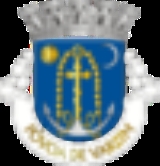
Póvoa de Varzim
Encyclopedia
Póvoa de Varzim (ˈpɔvuɐ dɨ vɐɾˈzĩ, locally [ˈpɔβuɐ dɨ bɐɾˈziŋ]) is a Portuguese
city in the Norte Region and sub-region of Greater Porto, with a 2011 estimated population of 63,364. According to the 2001 census, there were 63,470 inhabitants with 42,396 living in the city proper. The urban area expanded, southwards, to Vila do Conde, and there are about 100,000 inhabitants in the urban agglomeration alone. It is located in a sandy coastal plain, just south of Cape Santo André
, halfway between the Minho
and Douro
rivers.
Permanent habitation in Póvoa de Varzim dates back to around four to six thousand years ago; around 900 BC, unrest in the region led to the establishment of a fortified city. The ocean
has played an important part in its culture and economy, through maritime trade, and later through fishing
, leading it to acquire a Foral
in 1308 and to become, in the 18th century, the main fishing port in northern Portugal. Since the late 19th century, its beaches have helped it become one of the main tourist areas of the region.
Póvoa de Varzim is one of the few legal gambling
areas in Portugal, and has significant textile
and food
industries. The town has a rich seafood
cuisine, and retains ancient customs such as the writing system of siglas poveiras
and the masseira
farming technique.
stone tool
s suggest Póvoa de Varzim has been inhabited since the Lower Palaeolithic, around 200,000 BC. The first groups of shepherds settled on the coast where Póvoa de Varzim is now located between the 4th millennium and early 2nd millennium BC. Their dead were deposited in tumuli, which are the oldest monuments found in the municipality.
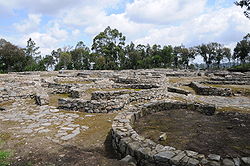 Widespread pillaging by rival tribes led the resident populations of the coastal plain of Póvoa de Varzim to raise a fortified town atop the hill that stood next to the sea. The city area covered 12000 m² (3 acre) and had several hundred inhabitants. It maintained commercial relations with the Mediterranean civilizations, during the Carthaginian dominion of the southern Iberian Peninsula
Widespread pillaging by rival tribes led the resident populations of the coastal plain of Póvoa de Varzim to raise a fortified town atop the hill that stood next to the sea. The city area covered 12000 m² (3 acre) and had several hundred inhabitants. It maintained commercial relations with the Mediterranean civilizations, during the Carthaginian dominion of the southern Iberian Peninsula
.
During the Punic Wars
, the Romans became aware of the Castro region's rich deposits of gold and tin. Viriathus
, leading Lusitanian
troops, hindered the expansion of the Roman Republic
north of the river Douro. His murder in 138 BC opened the way for the Roman legion
s. Over the following two years, Decimus Junius Brutus
advanced into the Castro region from south of the Douro
, crushed the Castro armies, and left Cividade de Terroso, in ruins.
The region was incorporated into the Roman Empire
and pacified during the reign of Caesar Augustus
. The Castro people returned to the coastal plain, where Villa Euracini was constructed. Fishing developed with the cetariæ, a Roman fish factory, for the production of garum
, an Ancient Roman fish sauce
condiment.
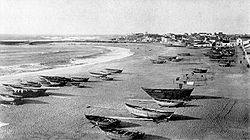 With the fall of the Roman Empire
With the fall of the Roman Empire
, Suevi populations established themselves in the region. Starting in the 9th century, Viking
fishermen originating from Brittany
raised a peaceful colony in Villa Euracini. In the following century, Viking raids took place throughout north-western Iberia. It was first mentioned as a Portuguese town on March 26, 953 during the rule of Countess Mumadona Dias
in the Era of the first County of Portugal. During the Middle Ages
, the name Euracini evolved to Uracini, Vracini, Veracini, Verazini, Verazim, and eventually Varazim.
The natural wealth of Varazim's coast attracted aristocrats and nobles to the land. The northern area belonged to the military order of the Knights Hospitaller
. It was named Varazim dos Cavaleiros (Knights' Varazim). The southern division of Varazim, the royal land, was important for fishery and agriculture, and disputes arose over the income brought in by fishing.
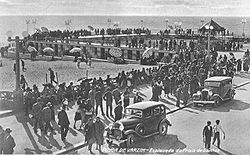 In 1308, King Denis
In 1308, King Denis
granted a charter (known in Portugal as a Foral
), giving the royal land to the 54 families of Varazim; these had to found a type of medieval town known as Póvoa. In 1312, King Denis donated the town to his bastard son, Afonso Sanches, Lord of Albuquerque, who included it in the patrimony of the Convent of Santa Clara, which he had just founded in Vila do Conde. In 1514, during the era of charter reform, King Manuel I
gave a new charter to Villa da Povoa de Varzim. The town gained a Town Hall, public square and a pillory
, and involved itself in the Portuguese discoveries
.
In the 17th century, the brine preservation business transformed Póvoa into the biggest fish market in northern Portugal. The 'Poveiros became known as "the people who worked the hardest and best knew the seas." The community became wealthier; following a royal provision by Queen Mary I, Corregedor Almada reorganized the town's layout to make it more attractive and thus provided potential for a new business — sea baths
.
In the 19th century, the town became popular as a summer destination for the upper classes of Porto and Minho
due to its large beaches and the development of leisure and private gambling businesses. In the end of that century, there were 17 casino
s. On February 27, 1892, a tragedy devastated the community. Seven lanchas poveiras wrecked in a storm and 105 fishermen were killed, just metres off the shore.
The thriving textile, food and tourist industries and the rail connection to Porto in 1875; and its development into the most popular holiday destination in northern Portugal, led to a major growth between the 1930s and 1960s.
In modern times, the fishing industry has lost much of its importance. Póvoa de Varzim is a service-sector city, but unlike other urban areas of Porto, it is not a dormitory community for commuters. Being one of northern Portugal's main locations, it developed a cosmopolitan style and serves as a centre for neighbouring towns.
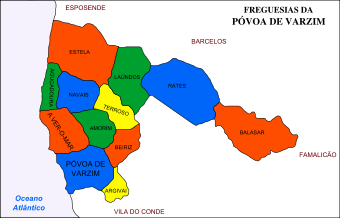 Occupying an area of 82.1 km2 or 31.7 sq mi (82.1 km²), Póvoa de Varzim lies between the Cávado
Occupying an area of 82.1 km2 or 31.7 sq mi (82.1 km²), Póvoa de Varzim lies between the Cávado
and Ave rivers, or, from a wider perspective, halfway between the Minho and Douro rivers on the northern coast of Portugal — the Costa Verde. It is bordered to the north by the municipality of Esposende, to the northeast by Barcelos, to the east by Vila Nova de Famalicão
, and to the south by Vila do Conde. To the west, it has a shoreline on the Atlantic Ocean
.
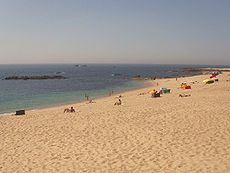
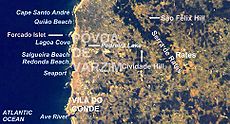 Wandering along the coast one discerns Cape Santo André
Wandering along the coast one discerns Cape Santo André
, the Avarus Promontory referred to by Ptolemy
, geographer of Ancient Greece
, in the territory of the Callaici
. The rocky cliff
s, common features downstream of the Minho's estuary
, disappear in Póvoa de Varzim, giving way to a coastal plain. The plain originates from an old marine plateau conferring a sandy soil to the lands that cross the coast, and forming sand dunes, mainly in northern Aguçadoura
.
São Félix Hill
(202 m (662.7 ft)) and Cividade Hill
(155 m (508.5 ft)) rise above the landscape. Despite their modest rise, the expanse of the plain makes them easy reference points on the horizon. The mountain chain known as Serra de Rates divides the municipality in two distinctive areas: the coastal plain and hills where the forests become more abundant and the soils have less sea influence. In this landscape dominated by the plain and low hills, only the hill of Corga da Soalheira (150 m (492.1 ft)) in the interior, is easily recognizable.
The municipality has no large rivers, but abundant small water courses exist. Some of these courses are permanent, such as the Este River, which feeds into the Ave. The source of the Esteiro River is located at the base of Cividade Hill and empties at the beach of Aver-o-Mar, while the Alto River's source is at the base of São Félix and reaches the Atlantic at Rio Alto Beach
. The land is well-irrigated, and springs and wells are very common, since underground water is often close to the surface.
The forest areas suffer from strong demographic pressure and intensive agriculture. Forests are still important in parishes surrounded by the Serra de Rates, whose flora is distinguished by the pedunculate oak
or the european holly
. In the 18th century, the monks of Tibães
planted pine
s, which characterized the civil parish of Estela. In the past the Atlantic forest predominated, with trees such as oak
s, ash tree
s, hazel
s, strawberry trees, holm oak
, and alder
s. The rocks throughout the entire coastline are home to large populations of clams, fish and seaweed. These rocks and the dunes form rich ecosystems, but are threatened by holiday-makers, dune sports and waterfront construction.
(Csb in the Köppen climate classification
system), with gentle summers and mild winters, influenced by the Atlantic ocean
. Average temperatures oscillate between 12.5 and 15 °C (54.5 and 59 F). The city possesses a microclimate
and is considered the region least subject to frost
s in all northern Portugal, and very uncommon snowfall, due to the winter winds that normally blow from the south and southwest.
The prevailing northern wind
s, known as Nortadas, arise in the summer after midday. During its dry summer, a mass of hot and wet air, brought by the south and western maritime winds, creates the city's characteristic fog
covering only the coast, which often dissipates with the afternoon sun. The annual precipitation varies between 1,200 and 1,400 mm (47.2 and 55 inches).
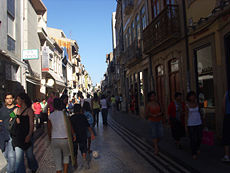 Located in the coastal plain between the sea and hills, the city of Póvoa de Varzim has eleven Partes (parts), or districts. These districts are, in turn, part of three formal administrative structures known as freguesia
Located in the coastal plain between the sea and hills, the city of Póvoa de Varzim has eleven Partes (parts), or districts. These districts are, in turn, part of three formal administrative structures known as freguesia
s (civil parishes): Póvoa de Varzim (parish)
, A Ver-o-Mar
, and Argivai
. To the south, the city is extending out to combine with Vila do Conde.
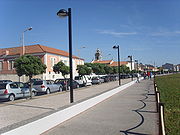
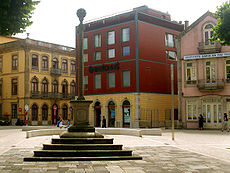
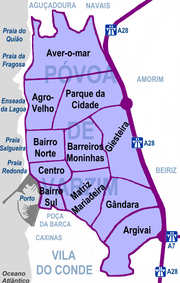 The city started from an inland town that extended to the coast. The Bairro da Matriz
The city started from an inland town that extended to the coast. The Bairro da Matriz
, whose nucleus was the centre from whence the city grew, is intersected by 14th century narrow and twisted streets lined by single family homes. The historical district has old buildings such as the sixteenth century house in front of Igreja Matriz — the first church, the old Town Hall (14th century), the seventeenth century Solar dos Carneiros and house of Captain Leite Ferreira, and the eighteenth century Limas and the Coentrão Houses. The fishermen were grouped in the south coast, around Póvoa Cove (Enseada da Póvoa); already in the 18th century, the fisher district, with its structure of narrow streets parallel to the coast, was developed.
Downtown Póvoa de Varzim
or Centro is dominated by the service sector and by the shopping streets of Junqueira and Mousinho de Albuquerque Avenue. Praça do Almada
, the central square, is tipped by City Hall, municipal departments, banks and other services. In the middle of the square, to the west, the Manueline
pillory of Póvoa de Varzim stands. The Pelourinho, erected in 1514, is a national monument representing the municipal emancipation of Póvoa de Varzim.
Bairro Norte
, the beach district, is north of town and is densely occupied. Continuous to this area, the Agro-Velho
beach district, also known as Nova Póvoa, is the area of the city with high-rises, the largest of which the Nova Póvoa, with 30 floors and 95 metres (311.7 ft) high, was built in the 1970s and is still today one of the ten tallest buildings in Portugal. Close at hand, Barreiros
and Parque da Cidade
are districts from the latest expansion.
Inland, Giesteira
, derived from the old village of Giesteira that, with Argivai, formed the main nucleus of the settlement before the 14th century, and whose lavradores (farmer
s) set up "Póvoa" in the coast. The parish of Argivai is divided by the Santa Clara Aqueduct, a Romanesque aqueduct and national monument built between 1626 and 1714. The old areas of Mariadeira
, Regufe
, Penalves
, and Gândara
have modest development, possess different topologies and are residential with small central areas. The Regufe Quarter has as symbol the Regufe Lighthouse, a sample from the 19th century iron art. Aver-o-mar is the northernmost urban coastal district and also of residential nature, with the exception of Santo André
also known as Quião, which keeps an untouched fishing character recognized by family homes that have grown up in a spontaneous way.
Of the diverse religious buildings the 18th century Baroque churches Baroque are prominent: the Matriz Church
, the Dores Church and its six chapels, and the fishermen Lapa Church, with its curious lighthouse. On the other hand, Misericórdia Church and Coração de Jesus Basilica
denote the preference for the Neoclassical style in the end of the 19th century.

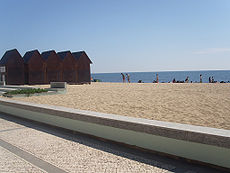 Póvoa de Varzim's beach is a 12 km, or 7.5 mi (12.1 km), stretch, forming sheltered bays and divided by rocks, rich in iodine
Póvoa de Varzim's beach is a 12 km, or 7.5 mi (12.1 km), stretch, forming sheltered bays and divided by rocks, rich in iodine
. Most beaches in the city are family-oriented such as Redonda
, Salgueira
or Lagoa Beach
and during the summer period it can get crowded while those away from the city core, such as Santo André
, are less crowded. Salgueira and Aguçadoura
are surfing beaches, while others such as Verde
and Quião Beach
are flirting areas. Located near a camping park, Rio Alto Beach
is chosen by naturists given its difficult access and the privacy offered by the sand dunes.
 The Póvoa de Varzim City Park
The Póvoa de Varzim City Park
, designed by Sidónio Pardal, is an urban park with almost 90 hectare, presently only the eastern part with 30 hectares is apt for visiting. While much of the park looks natural, it is almost entirely landscaped and includes hills, islands and lakes shaped by man. It stretches from the A28 freeway to Pedreira Lake.
São Félix Hill (Monte São Félix), with popular panoramic views over the city and the countryside, is a religious and forested hill that has the Senhora da Saúde Church at the foot of the hill and São Félix church at the summit. There's a gardened stairway throw the hill's slope. Rates Park is an adventure-camp with sport activities, canopy walkways, ecotourism by foot, horse, all-terrain vehicles or mountain biking. Damaged by the construction of high speed roads, Anjo woodland is expected to get a 5.2 hectare "urban green" access area.
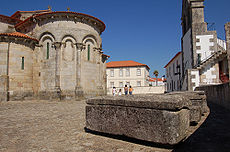 The green belt
The green belt
of Póvoa de Varzim is the group of civil parishes known as Aguçadoura, Amorim
, Balazar
, Beiriz
, Estela, Laundos
, Navais
, Rates
, and Terroso
. In these rural parishes, beyond the main rural communities, there are smaller villages, namely: Além
, Calves
, Fontaínhas
, Gândara
, Gestrins
, Gresufes
, Passô
, Sejães
, and Têso
.
Póvoa de Varzim countryside, land filled with myths and ancient history, is where the two hills of Póvoa are located: Cividade and São Félix, are located, in the parishes of Terroso and Laúndos, respectively. On the first hill, there is Cividade de Terroso, with 3 thousand years was one of the major Castro culture cities, and the eremite Saint Félix
lived on the second hill during the Middle Ages. In old times, the population attributed legends, magical virtues or therapeutic effects to several springs. Springs related with Saint Peter of Rates are located in Rates and Balazar. In Navais, there is the Moura Encontada Fountain, associated with Moura — a feminine water deity and guardian of enchanted treasures.
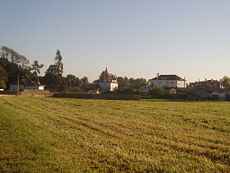 Rates is a small historic town that developed around the monastery established by Count Henry
Rates is a small historic town that developed around the monastery established by Count Henry
in 1100 on the site of an older temple and gained importance due to the legend of Saint Peter of Rates, first bishop of Braga, becoming a central site in the Portuguese way of Saint James
. The millenarian monastery, known as São Pedro de Rates Church, is one of the main Romanesque monuments in Portugal and is classified as national monument.
Next to Rates, the parish of Balazar
achieved religious importance and became a pilgrimage
destination in the 20th century due to Alexandrina Maria da Costa
, died 1955, who gained fame as a Saint, beatified
by Pope John Paul II
.
The parishes of Beiriz, Amorim and Aguçadoura are areas of transition between the urban and rural surroundings. Beiriz is recognized by its Beiriz carpets and Amorim for its bread eaten at high temperatures just after being made — the Broa de Amorim. In the northern sandy lands of the municipality, Aguçadoura can be found along with the parishes of Navais and Estela. Estela became a recreation area, and Aguçadoura supplies the metropolitan markets with horticultural goods.
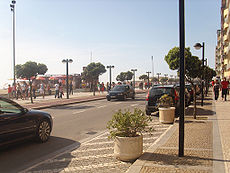
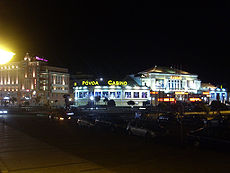 Junqueira is Póvoa de Varzim's busiest shopping district; the main street opened in 1694 and is a pedestrian area since 1955. It has about 1 km (0.621372736649807 mi) of pedestrian streets. Dotted with boutiques in old traditional buildings, Junqueira is renowned for its jewellery,Ourivesaria Gomes is a well known goldsmith in Portugal.
Junqueira is Póvoa de Varzim's busiest shopping district; the main street opened in 1694 and is a pedestrian area since 1955. It has about 1 km (0.621372736649807 mi) of pedestrian streets. Dotted with boutiques in old traditional buildings, Junqueira is renowned for its jewellery,Ourivesaria Gomes is a well known goldsmith in Portugal.
Póvoa de Varzim's waterfront is a beach and nightlife area popular with tourists and locals alike. Avenida dos Banhos
, along Redonda and Salgueira beaches, is an iconic avenue in the city, with nightclubs, bars, and esplanades along the way. Passeio Alegre
is a beach square filled with esplanades and nearby Caetano de Oliveira Square, to the north, is a small but lively square, with several bars where younger Poveiros meet, before going on to the nightclubs. Póvoa de Varzim was the first in Northern Portugal to have a gay pride festival between 2000 and 2005, organized by former Hit Club and ILGA Portugal, the event ended due to the real estate bobble on the area, with climbing rental prices.
Due to its geography and suitable urban areas, board culture is omnipresent in Póvoa de Varzim. Bodyboarders and surfers meet at Salgueira Beach. In Lota
, a recreation area for several audiences, is especially popular amongst the skater and biker communities, and is considered the most charismatic skater area in the country.
is a central gaming and entertainment venue since the 1930s. Egoísta Restaurant in the Casino offers haute cuisine
of local and Portuguese cuisine presented in a gourmet version, the restaurant is surrounded by an art gallery, exhibiting paintings from some of the finnest national artists such as Júlio Resende, Nikias Skapinakis or Rogério Ribeiro. In 2006, it was the second casino in revenues, with 54 million euros and the third most popular with 1.2 million customers.
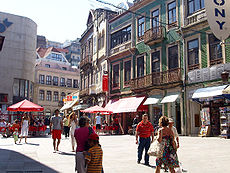 In the 19th century, Póvoa had over a dozen gambling venues, such as Salão Chinês, Café Suisso, Café David, Café Universal and Luso-Brasileiro. The Salão Chinês was the most charismatic and famous due to its fancy decoration and by having some of best dancing girls of the Iberian Peninsula
In the 19th century, Póvoa had over a dozen gambling venues, such as Salão Chinês, Café Suisso, Café David, Café Universal and Luso-Brasileiro. The Salão Chinês was the most charismatic and famous due to its fancy decoration and by having some of best dancing girls of the Iberian Peninsula
. Póvoa de Varzim has hotel
s. The most historic of which is the Grande Hotel da Póvoa, built in the 1930s, an arresting modernist building and, siding it, the Hotel Luso-Brasileiro, the oldest in town, running since the 19th century.
Póvoa's theatrical tradition, started with Teatro Garret (1873), Teatro Sá da Bandeira (1876), and Cine-Teatro Garrett (1890). The Auditório Municipal, is where the local school of music and the Octopus Film club coexist. The 19th century Garrett Teatre, now a public venue, will reopen after important structural reforms in 2010. The Varazim Teatro is a cultural and youth group of amateur theatre
that has encouraged local drama and A Filantrópica
, created in 1935, has as its purpose the execution of cultural activities and inducement to artistic creation. Some international meetings include the É-Aqui-in-Ócio, a drama festival, and the Festival Internacional de Música da Póvoa de Varzim, an erudite event established in 1978.
(1937) on Rua Visconde de Azevedo houses archaeological finds and exhibits relating to the seafaring history of the city. it is one of the oldest ethnic museums in Portugal and the "Siglas Poveiras" exhibit won the 1980 "European Museum of The Year Award". It possesses sacred art from the early first church (século XVI), faïence collection (16th to the 19th century) and archaeological finds such as the Roman inscriptions of Beiriz.
Two themed museums exist: the Museum Nucleus of the Romanesque Church of Saint Peter of Rates which is dedicated to the dissemination of the history, legend and art surrounding the Romanesque Church of Saint Peter of Rates, and the Archaeological Nucleus of Cividade de Terroso, which serves as a presentation of Cividade de Terroso. Another two museums are due to open: Casa do Pescador (Fisherman home) and Farol de Regufe (Regufe lighthouse).
The Ecomuseu de Rates is a green, historical and countryside route, with various stations starting on the Praça (the Square) with the Senhor da Praça baroque chapel, the Rates pillory and the old Rates township house, and primordial springs, wind and water mills, rustic ways and houses.
The Arquivo Municipal is the city's archive planned for those who are interested in tracing their family pedigree chart
or scrutinize the city's records.
 Diana Bar, currently the beach library, was a traditional writers meeting place since the 19th century, and was where José Régio passed his free time writing. Other famous writers closely associated with the city are Almeida Garrett
Diana Bar, currently the beach library, was a traditional writers meeting place since the 19th century, and was where José Régio passed his free time writing. Other famous writers closely associated with the city are Almeida Garrett
, Camilo Castelo Branco
, António Nobre
, and Agustina Bessa-Luís
. Nevertheless, the city is often remembered as the birthplace of Eça de Queiroz, one of the main writers in the Portuguese language
.
In modern times, the city gained international prominence with Correntes d'Escritas, a literary festival
where writers from the Portuguese
and Spanish-speaking world gather in a variety of presentations and an annual award for best new release.
, ray
, mackerel
, and others) and the "wealthy" fish (such as whiting, snook
, and alfonsino
). The most famous local dish is Pescada à Poveira (Poveira Whiting), whose main ingredients are, along with the fish that gives the name to the dish, potatoes, egg
s and a boiled onion and tomato sauce. Other fishery dishes include the Arroz de Sardinha (sardine rice), Caldeirada de Peixe (fish stew), Lulas Recheadas à Poveiro (Poveiro stuffed squids), Arroz de Marisco (seafood rice) and Lagosta Suada (steamed spiny lobster
). Shellfish
and boiled iscas, pataniscas, and bolinhos de bacalhau
are popular snacks. Other dishes include Feijoada
Poveira, made with white beans and served with dry rice (arroz seco); and Francesinha
Poveira made in long bread that first appeared in 1962 as fast food for holidaymakers.
Restaurant
s specializing in Portuguese barbecued chicken
, seafood, francesinha
, bacalhau
can be found along the Estrada Nacional 13 road.
The most popular sport in Póvoa de Varzim is association football. The City Park's Stadium and synthetic fields for football practice and athletics are the main stage for Póvoa de Varzim's People's championship where its football clubs compete: Aguçadoura, Amorim, Argivai, Averomar, Balasar, Barreiros, Beiriz, Belém, Estela, Juve Norte, Laundos, Leões da Lapa, Mariadeira, Matriz, Navais, Rates, Regufe, Terroso, and Unidos ao Varzim. Varzim SC is the professional football club of the city which plays in its own stadium near the beach; as of 2007, it played in the Liga de Honra
(2nd level), but several times has reached the Portuguese Liga
.
Swimming
is the second most practised sport. The International Meeting of Póvoa de Varzim, in long course pool, is part of the European winter calendar. The meeting occurs in the city pool complex belonging to Varzim Lazer, a municipal company that also runs other sports venues found north of the city: the tennis academy, the bullfighting arena, and the municipal pavilion. The other complex is property of Clube Desportivo da Póvoa, a club that is notorious, in the city, because it competes in several sports: rink hockey, volleyball
, basketball
, auto racing
, and athletics.
There is also an 18 hole golf course called Estela http://www.estelagolf.pt/
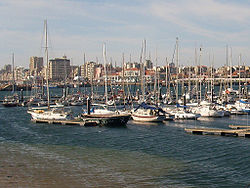 The Grande Prémio de São Pedro (Saint Peter Grand Prix), which occurs in the city's streets during the summer, is part of the national calendar of the Portuguese Athletics Federation. In 2007, the Grande Prémio da Marginal (Shoreline Grand Prix), an annual event between Póvoa de Varzim and Vila do Conde, aiming for the funding of the National Association of Paramiloidosis
The Grande Prémio de São Pedro (Saint Peter Grand Prix), which occurs in the city's streets during the summer, is part of the national calendar of the Portuguese Athletics Federation. In 2007, the Grande Prémio da Marginal (Shoreline Grand Prix), an annual event between Póvoa de Varzim and Vila do Conde, aiming for the funding of the National Association of Paramiloidosis
, was established in a bid to increase ties between both cities, as these share a common urban area. The Cego do Maio Half Marathon aims at the promotion of the city and the sport activity among the population. In Cycling
it hosts the Clássica da Primavera (Spring Classic) in April. The X BTT Cross Country Monte da Cividade and the newly created Grande Maratona Cidade da Póvoa de Varzim are the mountain bike
activities occurring in the municipality.
The marina, near the seaport, offers sea activities developed by the local yacht club
- the Clube Naval Povoense. Costa Verde Trophy, linking Póvoa and Viana do Castelo, is one of the regatta
s organized by the club and Rally Portugal yacht racing
is a sailing and sightseeing event along the west Iberian coast. Near São Félix Hill, the São Pedro de Rates shooting camp
is considered one of the best in Portugal and in Europe, with great prestige among nationals. There is also a links golf course
and a greyhound racing
track in Estela. The most important run in the local bullring
is a Portuguese-style bullfighting
known as Grande Corrida TV Norte (TV's Great Run - North) in late July. A harmless, traditional and fun bullfight, known as Garraida, with young bulls and students, occurs in early May as part of Porto's student festivities - the Queima das Fitas
.
(est. 1903), A Voz da Póvoa
(est. 1938), and Póvoa Semanário
, which appeared during the 1990s, are Póvoa de Varzim's major weekly newspaper
s; while the Gazeta da Póvoa de Varzim (1870–1874) was the first local newspaper. A Voz da Póvoa and Póvoa Semanário compete between themselves and are devoted, exclusively, to local news
and have Internet
editions.
The local radio station
s Rádio Mar (89.0) and Radio Onda Viva (96.1) broadcast on FM
and online. The stations' programming include local news and sports and feature an in-depth look at the city's top news by interviewing a guest at lunchtime on weekends. Radio Onda Viva airs Mandarin Chinese
programming daily. The radio station, Rádio Mar, and the newspaper Póvoa Semanário belong to the same group; the same company offers news services to the neighbouring cities of Vila do Conde and Esposende.
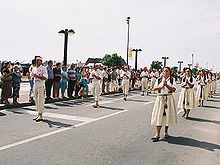 People in Póvoa de Varzim observe a variety of holidays and festivals each year. The major celebration is Saint Peter
People in Póvoa de Varzim observe a variety of holidays and festivals each year. The major celebration is Saint Peter
's, the fishermen's saint. The neighbourhoods are decorated; and, on the night of 28th to 29th the population dances and eats by the light of fires. Neighbourhoods compete in the rusgas (a carnival
) and the creation of thrones to Saint Peter. During the festivities, the population behaves much like football supporters, and there are disturbances when fans defend their preferred district. Families who emigrated to the United States and beyond, have been known to come back to Póvoa, time and again, simply to relish the spectacular feelings of excitement and community present at this festival.
Carnival
is a traditional festival in Póvoa de Varzim with the old Carnival Balls and the 1980s expensive carnival parades. The remains of such organized events are now celebrated spontaneously by the common people who gather for a parade in Avenida dos Banhos
. Despite not having any sort of advertising or media coverage, Póvoa's "Spontaneous Carnival" (Carnaval dos espontâneos) started to attract thousands of people. Easter Monday is considered to be the second "municipal holiday". The populace works on Good Friday (national holiday) to have Monday free to picnic
(Anjo festival), a remnant of a pagan festival, formerly called "Festa da Hera" (The Ivy Festival). The local companies follow this tradition and are open on Friday and closed on Monday.
On August 15, there is the Feast of the Assumption, one of the largest of this kind in Portugal, the pinnacle of the procession occurs in front of the seaport, where fireworks are launched from carefully arranged boats. In the last fortnight of September, during the Senhora das Dores festival, there is the century-old Senhora das Dores Pottery
Fair, with many tents, installed in the square near the Senhora das Dores Church, which sell diverse wares of traditional Portuguese pottery.
São Félix Hill is a reference point for fishermen at sea. On the last Sunday of May, the Pilgrimage of Nossa Senhora da Saúde (Our Lady of Health) covers a distance of 7 km (4.3 mi) between the Matriz Church and the Nossa Senhora da Saúde Chapel, at the foot of São Félix. In Cape Santo André there is a rocky formation known as Penedo do Santo or Saint's Rock, which has a mark that the Poveiro fishermen believe to be a footprint of Saint Andrew
(Santo André). They still believe that this saint is the "Boatman of Souls" and that he frees the souls of those who drown in the sea, fishing them from the depths of the ocean after a shipwreck. The celebration of Saint Andrew occurs on the dawn of the last day of November, when groups of men and women, wearing black hoods and holding lamps, go to the chapel via the beach.
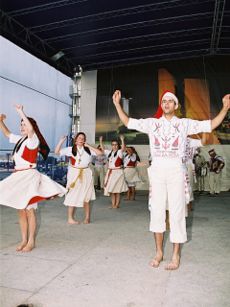 Poveiro culture is the result of what is found in the Minho Region influenced by the local fishery habits, protected and shaped by local factors over the course of generations. The docudrama film Ala-Arriba!
Poveiro culture is the result of what is found in the Minho Region influenced by the local fishery habits, protected and shaped by local factors over the course of generations. The docudrama film Ala-Arriba!
by José Leitão de Barros
, popularized this unique Portuguese fishing community within the country during the 1940s. The local expression ala-arriba
means "go (upwards)" and it represents the co-operation between the inhabitants.
Siglas Poveiras
are a form of proto-writing system, with a restricted number of symbols that were combined to form more complex symbols; these were used as a rudimentary visual communication system, and as a family coat of arms
or signature to mark belongings. Merchants wrote them in their books of credit; fishermen used it in religious rituals by marking them in the door of Catholic chapels near hills or beaches; in the table of their town’s first church during marriage; and also had magical significance, such as the São Selimão sigla, that could be used as a protecting symbol and not as family mark. Children used the same family mark with piques as a form of cadency
. The youngest son would not have any pique and would inherit the marca-brasão, his father's symbol. The siglas are still used, though much less commonly, by some families; and are, possibly, related with Viking traditions.
The camisolas poveiras are local pullovers
, with fishing motifs and name embroidered in sigla, made for celebration and decorative purposes. The pullovers were a local dress until 1892, when a misfortune at sea led the community to stop wearing it. It became popular again at the end of the 1970s. Today, there are efforts to modernize it on one hand and on the other there are endeavours to preserve the long-established practices. Other typical handicrafts are the internationally renowned Tapetes de Beiriz or Beiriz carpet
s, which are rustic carpets in which the carpet's pattern can be seen in the reverse side.
The Lancha Poveira is a boat that developed from the Drakkar Viking
, but without a long stern
and bow and with a Mediterranean sail. According to a tradition that persists to this day, the youngest son is the heir of the family, as in old Brittany
and Denmark
, because it was expected that he would take care of his parents when they became old. Women govern the family, because men were usually away from home fishing.
Formerly, the population was divided into different "caste
s": The Lanchões (those who possessed boats which were capable of deep-water fishing, therefore more prosperous), the Rasqueiros (the fisher "bourgeoisie" used "rasca" nets to fish rays, lobsters and crabs) and the Sardinheiros or Fanequeiros (those who possessed small boats and could only catch fish of smaller size along the shore) and, apart of them, the Lavradores (the farmers). As a rule, the groups remained distinct, and mixed marriages between them were forbidden, mostly because of the isolationism of the fishermen.
A native of Póvoa de Varzim is called a Poveiro which can be rendered into English as Povoan. According to the 2001 Census, there were 63,470 inhabitants that year, 38 848 (61.2%) of whom lived in the city. The number goes up to 100,000 if adjacent satellite areas are taken into account, ranking it as the seventh largest independent urban area in Portugal, within a polycentric agglomeration of about 3 million people, ranging from Braga to Porto.
The urban area has a population density of 3035/km2 (7,864/mi²), while the rural and suburban areas have a density of 355.5/km2 (920/mi²). The rural areas away from the city tend to be scarcely populated, becoming denser near it. During the summer the resident population in the city triples; this seasonal movement from neighbouring cities is due to the draw of the beach and 29.9% of homes had seasonal use in 2001, the highest in Greater Porto. Póvoa de Varzim is the youngest city in the region with a birth rate
of 13.665 and mortality rate
of 8.330. Unlike other urban areas of greater Porto, it is not a satellite city. Significant commuting occurs only with Vila do Conde, an urban expansion area of Póvoa since the 18th century.
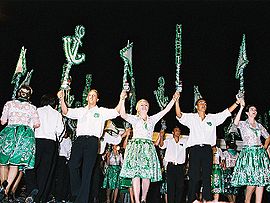 For centuries a fishing community of mostly Norman origin, where ethnic isolationism was a common practice, Póvoa de Varzim is today a cosmopolitan town, with people originating from the Ave Valley who settled in the coastal Northern districts during the 20th century, the ancient immigration from Galicia, Portuguese-Africans (who arrived in significant numbers after the independence of Angola
For centuries a fishing community of mostly Norman origin, where ethnic isolationism was a common practice, Póvoa de Varzim is today a cosmopolitan town, with people originating from the Ave Valley who settled in the coastal Northern districts during the 20th century, the ancient immigration from Galicia, Portuguese-Africans (who arrived in significant numbers after the independence of Angola
and Mozambique
) in late 1970s) and people of diverse nationalities, the biggest immigrant communities are Ukrainians
, Brazil
ians, Chinese, Russians, and Angola
ns.
The population of the entire municipality grew only 1% between 1981 and 1991, then increased by 15.3% between 1991 and 2001. During that period, the urban population had grown 23%, with the number of families increasing considerably — by about 44.5%. In 2005 Expresso
considered it as the most developed in Porto district and Primeiro de Janeiro
as the "city of future" in the Porto district, the quality of living, the infrastructure development such as the light rail metro and a 15 minutes distance from Porto and Braga, prompted new residents originating from near-by cities such as Guimarães
, Famalicão, Braga and Porto which lead to a real estate
development that may double the resident population in the medium term.
Due to the practice of endogamy
and the caste
system, Póvoa's fishing community maintained local ethnic characteristics. Anthropological and cultural data indicate Nordic
fishermen settling during the period of the coast's resettlement. In As Praias de Portugal (Beaches of Portugal, 1876), Ramalho ortigão wrote that the Povoan fishermen were a "race" in the Portuguese coast; entirely different from the Mediterranean type of Ovar and Olhão, Poveiro is of "Saxon" type. On the other hand, the man from the interior was a farmer with Galician character (Paleo and Nordid-Atlantid). In a 1908 research, anthropologist Fonseca Cardoso considered that Poveiros were the result of a mixture of Phoenicians, Teutons, Jews and, mostly, Normans. In the book The Races of Europe (1938), Poveiros were distinguished by having a greater than usual degree of blondism, broad faces of unknown origin, and broad jaws.
Poveiros have migrated to other places and this attenuated the population growth. One should notice that the Poveiros tended to create their own associations abroad, there are Casa dos Poveiros (Poveiros House) in Brazil (Rio de Janeiro
and São Paulo
), Germiston in South Africa and Toronto
in Canada. In Rio de Janeiro, the community was known by not wanting other peoples of other origins, including Portuguese born in other regions, within their community. In 1920, many Poveiros emigrated in Brazil returned, as many refused to lose Portuguese nationality. The governor of Angola, with an ambition to develop fisheries, suggested the creation of a Povoan colony in Porto Alexandre. Due to fisher classes affairs, the fisher areas of Vila do Conde, Esposende and Matosinhos have strong Povoan cultural influence and half of the population of Vila do Conde and Matosinhos are of Povoan descent.
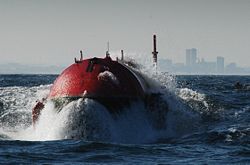
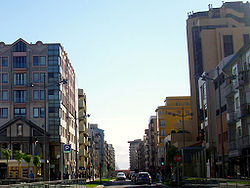 The economy of Póvoa de Varzim is driven by tourism (namely gambling, hotels and restaurants), manufacturing, construction, fishing, and agriculture. During the 2001 census, 1770 companies are headquartered in Póvoa de Varzim, of which 2.82% were of the primary sector, 33.73% of the secondary and 63.45% of the tertiary, including software companies operating nationally and abroad. Despite its weight in Greater Porto international trade is weak, in 2004 it represented 1.1% of departures and 0.9% of arrivals, its coverage rate of arrivals against departures suppressed the 100% mark. The activity rate had grown from 48% to 51.1% from 1991 to 2001, but there were 3353 citizens unemployed in June 2006.
The economy of Póvoa de Varzim is driven by tourism (namely gambling, hotels and restaurants), manufacturing, construction, fishing, and agriculture. During the 2001 census, 1770 companies are headquartered in Póvoa de Varzim, of which 2.82% were of the primary sector, 33.73% of the secondary and 63.45% of the tertiary, including software companies operating nationally and abroad. Despite its weight in Greater Porto international trade is weak, in 2004 it represented 1.1% of departures and 0.9% of arrivals, its coverage rate of arrivals against departures suppressed the 100% mark. The activity rate had grown from 48% to 51.1% from 1991 to 2001, but there were 3353 citizens unemployed in June 2006.
Póvoa de Varzim has been noted internationally for its Renewable energy industry. The world's first commercial wave farm is located in its coast, at the Aguçadora Wave Park. The wave farm uses three Pelamis P-750 machines
with a capacity of 2.25 megawatts, enough to meet the average electricity demand of more than 1,500 Portuguese households. In the first phase, the park will produce 2.25 megawatts, enough energy for 1500 homes. Energy self-sustainability is foreseen with the expansion of the wave park to 28 machines capable to produce 24 mW, supplying 250 thousand inhabitants, 10% of that energy, capable of supplying one third of the population of the municipality, will be assigned to the city. Energie, a company headquartered in Póvoa de Varzim, developed a thermodynamic solar system combining solar energy and a heat pump to generate energy even when it is night or overcast; the success of this technology internationally led the company to open in a large factory, that started operating in 2007.
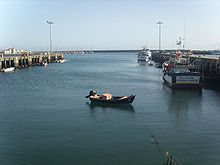
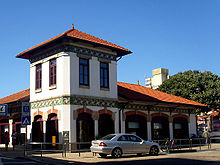 The fact that it is a seaside city has shaped Póvoa de Varzim's economy: the fishing industry, from the fishing vessels that put in each day to the canning industry and to the city's fish market, beach agriculture, seaweed-gathering for fertilizing fields, and tourism are the result of its geography. Tourism and the related industries are more relevant in Póvoa's economy these days, as fisheries have lost importance. Nevertheless, the mean value of fish landed in 2004, in its seaport, was almost three times that of Matosinhos
The fact that it is a seaside city has shaped Póvoa de Varzim's economy: the fishing industry, from the fishing vessels that put in each day to the canning industry and to the city's fish market, beach agriculture, seaweed-gathering for fertilizing fields, and tourism are the result of its geography. Tourism and the related industries are more relevant in Póvoa's economy these days, as fisheries have lost importance. Nevertheless, the mean value of fish landed in 2004, in its seaport, was almost three times that of Matosinhos
seaport and significantly higher in the average vessels' capacity. Its fishing productivity is also comparatively higher than the national average.
Monte Adriano, the seventh largest construction company in Portugal, and the joint venture between the Royal Lankhorst Euronete and Quintas & Quintas, producer of deepwater mooring systems, are two large companies based in the city. The manufacturing industry is an important employer, mostly in the textile industry that has low productivity and income. These industries are located out of the city in Beiriz, Balasar, and Rates. Other employers include the blanket handicraft
industry of Terroso and Laundos, and the wood industries of Rates. One of the initiatives of the municipality is the Parque Industrial de Laundos (Industrial Park of Laundos), in the city's outskirts, next to the A28 Motorway.
Póvoa de Varzim is one of the principal food suppliers for Greater Porto and is part of the ancient Vinho Verde
winemaking region. The coastal populations developed the masseira
farm fields. This technique increases agricultural yields by using large, rectangular depressions dug into sand dunes, with the spoil piled up into banks surrounding the depression. Grapes are cultivated on the banks to the south, east and west, and trees and reeds on the northern slope act as a windbreak
against the prevailing northern wind. Garden crops are grown in the central depression. Production is still specialized in horticultural goods, but most of the masseiras were substituted by greenhouse
s. The inland valley region is committed to milk production and the Agros Enterprise Centre of Lactogal
, the largest dairy products and milk producer company in Portugal, is under construction and will be the corporation headquarters and will have several departments such as exhibition park and laboratories, thus becoming the largest agricultural project in the north of Portugal.
Póvoa de Varzim is governed by a Câmara Municipal (City Council) composed of nine councilmen. A Municipal Assembly exists and it is the legislative body of the municipality, consisting of 39 members, twelve of whom are presidents of civil parishes.
After the 2009 municipal elections, five councilmen were members of the centre-right Partido Social Democrata
(PSD), three of the centre-left Partido Socialista
(PS) and one of the right-wing Centro Democrático e Social - Partido Popular
(CDS-PP). The mayor is Macedo Vieira
, for the PSD, elected with 46.29% of the votes. The PSD holds the majority of public offices both in the Municipal Assembly and in the civil parishes. After the first free elections, with the end of the Estado Novo period, only right-wing parties have governed the city: the city council was governed by the CDS
between 1976 and 1989 and since then by the PSD. The CDS saw its popularity suffer an abrupt decline in 1997, and has since then been the third political party. On the other hand, the PSD in the same year achieved its first absolute majority with 62.4% of the votes.
Póvoa de Varzim is the northernmost municipality in the Porto Metropolitan Area, about 27 km (16.8 mi) north of downtown Porto. Despite being enclosed in the northern metropolis, Póvoa de Varzim is part of the Association of Municipalities of the Ave Valley.
Between 1308 and 1836, the municipality was made up of a single parish territory of which, over time, grew to approach the medieval borders. With the administrative reform of the land in 1836, Póvoa de Varzim annexed Rates township, regained the remaining domains of Argivai, and obtained Balasar, Estela, Laúndos, Navais, Terroso, Outeiro Maior, Parada, Rio Mau, and Santagões. In 1853, it exchanged the preceding four with nearby Vila do Conde and got Amorim and Beiriz. The civil parishes of Aver-o-Mar and Aguçadoura were created in early 20th century through the dismemberment of Amorim and Navais, respectively. The settlement of Aver-o-Mar was first annexed in the 17th century due to an emergent community of fishing-farmers. On the other hand, Caxinas and Poça da Barca, south expansion areas of Póvoa de Varzim in the 18th and 19th centuries with fisher populations from Póvoa, are still administrated by Vila do Conde, in spite of the centuries-old requests of Póvoa de Varzim for these to be incorporated in its municipality.
The origin of the coat of arms of Póvoa de Varzim is unknown, but it certainly has local traits and symbolism. The coat of arms is composed of a golden sun and a silver moon; in the middle a golden cross completed by two anchor silver arms, representing safety at sea. Over the cross, a ring, of which falls a golden rosary that interlaces with the anchor arms, representing faith and divine protection. The crest is made of five silver towers due to its city status. The flag is broken in blue and white. Between 1939 and 1958, a different coat of Arms and flag were used, which the population criticized; it consisted of a golden shield, covered by a red net, the sea and a black Poveiro boat; the flag was plain red. The population did not accept these new symbols and years later the old ones would be restored.
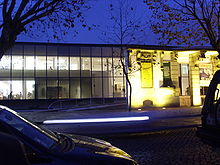 Póvoa de Varzim has public, denominational and independent school
Póvoa de Varzim has public, denominational and independent school
s in the city and rural areas. Public education in the municipality is provided by five school districts: Flávio Gonçalves, Cego do Maio, Aver-o-Mar, Campo Aberto, and Rates. These school districts arrange kindergartens and schools to the 9th grade of different locales of the municipality and are headed by Escolas de Educação Básica do 2.° e 3.°Ciclo (6th to the 9th grade schools) that give the name to each district. Private schools are primarily run by Catholic parishes or groups, but the Grande Colégio da Póvoa de Varzim and Campo Verde School of Agriculture are eminent independent schools and MAPADI is a large facility and school for children with down syndrome
. Colégio do Sagrado Coração de Jesus, where Agustina Bessa-Luís studied, reopened in the 2007-2008 school year, planning to become a leading catholic school.
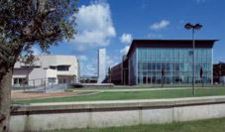 High schools (10th to the 12th grade) are situated in the Póvoa city centre
High schools (10th to the 12th grade) are situated in the Póvoa city centre
: Escola Secundária Eça de Queirós and Escola Secundária Rocha Peixoto. The Colégio de Amorim is an independent school in the civil parish of Amorim that also offers secondary education. Eça de Queirós was a lyceum
created in 1904 that maintains its humanist outlook and Rocha Peixoto was a former industrial and commercial school created in 1924.
The Porto Polytechnic runs, jointly in Póvoa de Varzim and Vila do Conde, the Superior School of Industrial Studies and Management
(ESEIG), which once was based in two campuses, one in each city, but it was united in a single new school, on the border between the two cities. A little more than one quarter of the population now has intermediate or superior level qualifications. The illiteracy level was 5.9 percent in 2001.
The Rocha Peixoto Municipal Library, established in 1880, on the 300th anniversary of the death of Luís de Camões
was housed in the current building in 1991. Small libraries known as Pólos de leitura, located in the countryside, and Diana Bar Beach Library are extension posts of the municipal library.
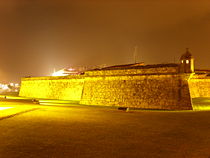 The first healthcare structure, the Santa Casa da Misericórdia da Póvoa de Varzim (Holy House of Mercy), opened in 1756. The hospitals of the city are the São Pedro Pescador Hospital (state-run) and Clipóvoa Hospital (private). The public hospital suffers from lack of bed spaces. Due to this, there is an on-going plan to build a modern hospital, in the border between the cities of Póvoa de Varzim and Vila do Conde, to serve the population of both municipalities. The Centro de Saúde da Póvoa de Varzim (Health Centre) is a public primary care
The first healthcare structure, the Santa Casa da Misericórdia da Póvoa de Varzim (Holy House of Mercy), opened in 1756. The hospitals of the city are the São Pedro Pescador Hospital (state-run) and Clipóvoa Hospital (private). The public hospital suffers from lack of bed spaces. Due to this, there is an on-going plan to build a modern hospital, in the border between the cities of Póvoa de Varzim and Vila do Conde, to serve the population of both municipalities. The Centro de Saúde da Póvoa de Varzim (Health Centre) is a public primary care
building which has extensions in the main parishes.
The Municipal Police of Póvoa de Varzim, one of the first to be established in the country, is an administrative police force that acts solely within the municipality and reports directly to the mayor. The Polícia de Segurança Pública
(PSP) does the city policing, while the Guarda Nacional Republicana (GNR) is responsible for the countryside. In terms of crime, Póvoa de Varzim is considered by the Polícia de Segurança Pública
as a "calm" zone in all categories of offense; violent crime, in particular, is practically non-existent. Mostly, crime consists of minor robberies to homes, stores, or from cars.
Póvoa is one of the twelve national sea borders controlled by the Serviço de Estrangeiros e Fronteiras (SEF). The Escola Prática dos Serviços, just east of the city by the A28 motorway, is the national headquarters for military administration instruction, with the Battalion of Military Administration, and, due to the reorganization of army services, the former Escola Prática de Administração Militar, from 2006 onwards it gained the material and transport services, thus increasing its range of functions and troop numbers.
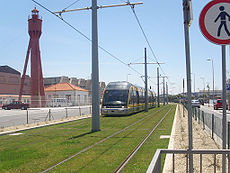 Póvoa de Varzim is served by a transportation network that employs maritime, aerial and terrestrial travel. The terrestrial access infrastructure is composed of national motorways (freeways), the national roads system, and light rail
Póvoa de Varzim is served by a transportation network that employs maritime, aerial and terrestrial travel. The terrestrial access infrastructure is composed of national motorways (freeways), the national roads system, and light rail
metro. These infrastructures and the airport, bus terminal, marina and harbour are daily used by commuters.
.jpg)
 Public transportation within the city is provided by private-owned companies. Streetcars appeared in 1874 and endured until the first years of the 20th century. The Central de Camionagem is a terminus for urban and long distance buses that provide mass transit in the surrounding region, namely the city's countryside, Porto, Minho Region, and Galicia in Spain. Litoral Norte as a wholly urban transportation network with 5 lines, while Linhares has the oldest bus network operating in the city, now owned by Transdev.
Public transportation within the city is provided by private-owned companies. Streetcars appeared in 1874 and endured until the first years of the 20th century. The Central de Camionagem is a terminus for urban and long distance buses that provide mass transit in the surrounding region, namely the city's countryside, Porto, Minho Region, and Galicia in Spain. Litoral Norte as a wholly urban transportation network with 5 lines, while Linhares has the oldest bus network operating in the city, now owned by Transdev.
The Francisco Sá Carneiro Airport
(OPO) is located 18 km (11.2 mi) south of the city. It is one of the busiest international airports in Portugal and serves all Greater Porto. Póvoa Aerodrome, officially known as S. Miguel de Laundos, is small-sized, with only 270 meters long for ultralight aviation
and other small planes.
Line B of Porto Metro
links Póvoa de Varzim to Porto and the airport with two services: a standard and a shuttle (the Expresso); through Verdes station, Metro trains link the city and the airport. The line operates on a former railway, which opened in 1875 and closed in 2002 to give way for the metro. The railway network was expanded and reached Famalicão in 1881, it was closed entirely in 1995 and expected to become a rail trail
.
The city is connected by road on a north-south axis from Valença
, Viana do Castelo, and Esposende to Porto
by the A28
motorway. It is also reached by the A7
(from Guimarães
and Vila Nova de Famalicão
) and A11
(from Braga
and Barcelos
) motorways on an east-west axis, through the south and north of the city, in that order, and both cross the A28. Although it lost usefulness for average and long distances, the National Roads system has acquired municipal interest: EN13 that cuts the city in half, in a north-south direction, is used by commuters originating from the northern parishes and from the city of Vila do Conde, in the south, to travel downtown. The EN205 and the EN206 are used by commuters starting from the interior of the municipality.
The traditional road system of the city, composed of roads that run parallel in the direction of the sea, can be seen in any of the following avenues: Avenida do Mar, Avenida Vasco da Gama, Avenida Mouzinho de Albuquerque, and Avenida Santos Graça. The Avenida dos Descobrimentos and Avenida dos Banhos
, in other hand, run parallel to the coast. The growth of the city inland and northwards made ring road
s more important, this can be seen in Avenida 25 de Abril, an urban belt road.
, Póvoa de Varzim is twinned, since 1986, with the city of Montgeron
in France, with Rio de Janeiro
(Brazil
) in 1989, with Eschborn
in Germany (since 1998) and Żabbar
in Malta
(since 2001) and it received, due to the partnership with other European cities, the 1995 and 2005 Golden Stars of Town-twinning from the European Commission
.
Portugal
Portugal , officially the Portuguese Republic is a country situated in southwestern Europe on the Iberian Peninsula. Portugal is the westernmost country of Europe, and is bordered by the Atlantic Ocean to the West and South and by Spain to the North and East. The Atlantic archipelagos of the...
city in the Norte Region and sub-region of Greater Porto, with a 2011 estimated population of 63,364. According to the 2001 census, there were 63,470 inhabitants with 42,396 living in the city proper. The urban area expanded, southwards, to Vila do Conde, and there are about 100,000 inhabitants in the urban agglomeration alone. It is located in a sandy coastal plain, just south of Cape Santo André
Cape Santo André
Cape Santo André is a cape located in the Northern coast of continental Portugal, in Santo André, municipality of Póvoa de Varzim....
, halfway between the Minho
Minho River
The Minho or Miño is the longest river in Galicia, Spain, with an extension of 340 km.Both names come from Latin Minius...
and Douro
Douro
The Douro or Duero is one of the major rivers of the Iberian Peninsula, flowing from its source near Duruelo de la Sierra in Soria Province across northern-central Spain and Portugal to its outlet at Porto...
rivers.
Permanent habitation in Póvoa de Varzim dates back to around four to six thousand years ago; around 900 BC, unrest in the region led to the establishment of a fortified city. The ocean
Ocean
An ocean is a major body of saline water, and a principal component of the hydrosphere. Approximately 71% of the Earth's surface is covered by ocean, a continuous body of water that is customarily divided into several principal oceans and smaller seas.More than half of this area is over 3,000...
has played an important part in its culture and economy, through maritime trade, and later through fishing
Fishing
Fishing is the activity of trying to catch wild fish. Fish are normally caught in the wild. Techniques for catching fish include hand gathering, spearing, netting, angling and trapping....
, leading it to acquire a Foral
Foral
thumb|left|200px|Foral of Castro Verde - PortugalThe word foral derives from the Portuguese word foro, ultimately from Latin forum, equivalent to Spanish fuero, Galician foro, Catalan furs and Basque foru ....
in 1308 and to become, in the 18th century, the main fishing port in northern Portugal. Since the late 19th century, its beaches have helped it become one of the main tourist areas of the region.
Póvoa de Varzim is one of the few legal gambling
Gambling
Gambling is the wagering of money or something of material value on an event with an uncertain outcome with the primary intent of winning additional money and/or material goods...
areas in Portugal, and has significant textile
Textile industry
The textile industry is primarily concerned with the production of yarn, and cloth and the subsequent design or manufacture of clothing and their distribution. The raw material may be natural, or synthetic using products of the chemical industry....
and food
Food industry
The food production is a complex, global collective of diverse businesses that together supply much of the food energy consumed by the world population...
industries. The town has a rich seafood
Seafood
Seafood is any form of marine life regarded as food by humans. Seafoods include fish, molluscs , crustaceans , echinoderms . Edible sea plants, such as some seaweeds and microalgae, are also seafood, and are widely eaten around the world, especially in Asia...
cuisine, and retains ancient customs such as the writing system of siglas poveiras
Siglas poveiras
The siglas poveiras is a proto-writing system that has been used by the local community of Póvoa de Varzim in Portugal for many generations. The siglas were primarily used as a signature for family coat-of-arms in order to mark family belongings...
and the masseira
Masseira
Masseira is a unique form of traditional farming technique practised in the parishes of Estela and Aguçadoura in the north of Póvoa de Varzim in Portugal, and in the neighbouring parish of Apúlia in Esposende...
farming technique.
History
Discoveries of AcheuleanAcheulean
Acheulean is the name given to an archaeological industry of stone tool manufacture associated with early humans during the Lower Palaeolithic era across Africa and much of West Asia, South Asia and Europe. Acheulean tools are typically found with Homo erectus remains...
stone tool
Stone tool
A stone tool is, in the most general sense, any tool made either partially or entirely out of stone. Although stone tool-dependent societies and cultures still exist today, most stone tools are associated with prehistoric, particularly Stone Age cultures that have become extinct...
s suggest Póvoa de Varzim has been inhabited since the Lower Palaeolithic, around 200,000 BC. The first groups of shepherds settled on the coast where Póvoa de Varzim is now located between the 4th millennium and early 2nd millennium BC. Their dead were deposited in tumuli, which are the oldest monuments found in the municipality.

Iberian Peninsula
The Iberian Peninsula , sometimes called Iberia, is located in the extreme southwest of Europe and includes the modern-day sovereign states of Spain, Portugal and Andorra, as well as the British Overseas Territory of Gibraltar...
.
During the Punic Wars
Punic Wars
The Punic Wars were a series of three wars fought between Rome and Carthage from 264 B.C.E. to 146 B.C.E. At the time, they were probably the largest wars that had ever taken place...
, the Romans became aware of the Castro region's rich deposits of gold and tin. Viriathus
Viriathus
Viriathus was the most important leader of the Lusitanian people that resisted Roman expansion into the regions of Western Hispania , where the Roman province of Lusitania would be established...
, leading Lusitanian
Lusitanians
The Lusitanians were an Indo-European people living in the Western Iberian Peninsula long before it became the Roman province of Lusitania . They spoke the Lusitanian language which might have been Celtic. The modern Portuguese people see the Lusitanians as their ancestors...
troops, hindered the expansion of the Roman Republic
Roman Republic
The Roman Republic was the period of the ancient Roman civilization where the government operated as a republic. It began with the overthrow of the Roman monarchy, traditionally dated around 508 BC, and its replacement by a government headed by two consuls, elected annually by the citizens and...
north of the river Douro. His murder in 138 BC opened the way for the Roman legion
Roman legion
A Roman legion normally indicates the basic ancient Roman army unit recruited specifically from Roman citizens. The organization of legions varied greatly over time but they were typically composed of perhaps 5,000 soldiers, divided into maniples and later into "cohorts"...
s. Over the following two years, Decimus Junius Brutus
Decimus Junius Brutus Callaicus
Decimus Junius Brutus Callaicus was a Roman politician and general of the 2nd century BC. He was the son of the consul Marcus Junius Brutus and brother of the praetor Marcus Junius Brutus; he himself was appointed consul in 138 BC...
advanced into the Castro region from south of the Douro
Douro
The Douro or Duero is one of the major rivers of the Iberian Peninsula, flowing from its source near Duruelo de la Sierra in Soria Province across northern-central Spain and Portugal to its outlet at Porto...
, crushed the Castro armies, and left Cividade de Terroso, in ruins.
The region was incorporated into the Roman Empire
Roman Empire
The Roman Empire was the post-Republican period of the ancient Roman civilization, characterised by an autocratic form of government and large territorial holdings in Europe and around the Mediterranean....
and pacified during the reign of Caesar Augustus
Augustus
Augustus ;23 September 63 BC – 19 August AD 14) is considered the first emperor of the Roman Empire, which he ruled alone from 27 BC until his death in 14 AD.The dates of his rule are contemporary dates; Augustus lived under two calendars, the Roman Republican until 45 BC, and the Julian...
. The Castro people returned to the coastal plain, where Villa Euracini was constructed. Fishing developed with the cetariæ, a Roman fish factory, for the production of garum
Garum
Garum, similar to liquamen, was a type of fermented fish sauce condiment that was an essential flavour in Ancient Roman cooking, the supreme condiment....
, an Ancient Roman fish sauce
Fish sauce
Fish sauce is a condiment that is derived from fish that have been allowed to ferment. It is an essential ingredient in many curries and sauces. Fish sauce is a staple ingredient in numerous cultures in Southeast Asia and the coastal regions of East Asia, and features heavily in Thai and Vietnamese...
condiment.

Roman Empire
The Roman Empire was the post-Republican period of the ancient Roman civilization, characterised by an autocratic form of government and large territorial holdings in Europe and around the Mediterranean....
, Suevi populations established themselves in the region. Starting in the 9th century, Viking
Viking
The term Viking is customarily used to refer to the Norse explorers, warriors, merchants, and pirates who raided, traded, explored and settled in wide areas of Europe, Asia and the North Atlantic islands from the late 8th to the mid-11th century.These Norsemen used their famed longships to...
fishermen originating from Brittany
Brittany
Brittany is a cultural and administrative region in the north-west of France. Previously a kingdom and then a duchy, Brittany was united to the Kingdom of France in 1532 as a province. Brittany has also been referred to as Less, Lesser or Little Britain...
raised a peaceful colony in Villa Euracini. In the following century, Viking raids took place throughout north-western Iberia. It was first mentioned as a Portuguese town on March 26, 953 during the rule of Countess Mumadona Dias
Mumadona Dias
Mumadona Dias, or Muniadomna Díaz, Countess of Portugal in the 10th century, ruling between c. 924 - c. 950. She was daughter of Count Diogo Fernandes and of countess Onega....
in the Era of the first County of Portugal. During the Middle Ages
Middle Ages
The Middle Ages is a periodization of European history from the 5th century to the 15th century. The Middle Ages follows the fall of the Western Roman Empire in 476 and precedes the Early Modern Era. It is the middle period of a three-period division of Western history: Classic, Medieval and Modern...
, the name Euracini evolved to Uracini, Vracini, Veracini, Verazini, Verazim, and eventually Varazim.
The natural wealth of Varazim's coast attracted aristocrats and nobles to the land. The northern area belonged to the military order of the Knights Hospitaller
Knights Hospitaller
The Sovereign Military Hospitaller Order of Saint John of Jerusalem of Rhodes and of Malta , also known as the Sovereign Military Order of Malta , Order of Malta or Knights of Malta, is a Roman Catholic lay religious order, traditionally of military, chivalrous, noble nature. It is the world's...
. It was named Varazim dos Cavaleiros (Knights' Varazim). The southern division of Varazim, the royal land, was important for fishery and agriculture, and disputes arose over the income brought in by fishing.

Denis of Portugal
Dinis , called the Farmer King , was the sixth King of Portugal and the Algarve. The eldest son of Afonso III of Portugal by his second wife, Beatrice of Castile and grandson of king Alfonso X of Castile , Dinis succeeded his father in 1279.-Biography:As heir to the throne, Infante Dinis was...
granted a charter (known in Portugal as a Foral
Foral
thumb|left|200px|Foral of Castro Verde - PortugalThe word foral derives from the Portuguese word foro, ultimately from Latin forum, equivalent to Spanish fuero, Galician foro, Catalan furs and Basque foru ....
), giving the royal land to the 54 families of Varazim; these had to found a type of medieval town known as Póvoa. In 1312, King Denis donated the town to his bastard son, Afonso Sanches, Lord of Albuquerque, who included it in the patrimony of the Convent of Santa Clara, which he had just founded in Vila do Conde. In 1514, during the era of charter reform, King Manuel I
Manuel I of Portugal
Manuel I , the Fortunate , 14th king of Portugal and the Algarves was the son of Infante Ferdinand, Duke of Viseu, , by his wife, Infanta Beatrice of Portugal...
gave a new charter to Villa da Povoa de Varzim. The town gained a Town Hall, public square and a pillory
Pillory
The pillory was a device made of a wooden or metal framework erected on a post, with holes for securing the head and hands, formerly used for punishment by public humiliation and often further physical abuse, sometimes lethal...
, and involved itself in the Portuguese discoveries
Portugal in the Age of Discovery
During the history of Portugal between 1415 and 1578, Portugal discovered an eastern route to India that rounded the Cape of Good Hope, discovered Brazil, established trading routes throughout most of southern Asia, colonized selected areas of Africa, and sent the first direct European maritime...
.
In the 17th century, the brine preservation business transformed Póvoa into the biggest fish market in northern Portugal. The 'Poveiros became known as "the people who worked the hardest and best knew the seas." The community became wealthier; following a royal provision by Queen Mary I, Corregedor Almada reorganized the town's layout to make it more attractive and thus provided potential for a new business — sea baths
Sea bathing
Sea bathing is swimming in the sea or in sea water and a sea bath is a protective enclosure for sea bathing. Unlike bathing in a swimming pool, which is generally done for pleasure or exercise purposes, sea bathing was once thought to have curative or therapeutic value. It arose from the medieval...
.
In the 19th century, the town became popular as a summer destination for the upper classes of Porto and Minho
Entre Douro e Minho
Entre Douro e Minho is one of the historical provinces of Portugal which encompassed the country's northern Atlantic seaboard between the Douro and Minho rivers. Contemporaries often referred to the province as simply "Minho"...
due to its large beaches and the development of leisure and private gambling businesses. In the end of that century, there were 17 casino
Casino
In modern English, a casino is a facility which houses and accommodates certain types of gambling activities. Casinos are most commonly built near or combined with hotels, restaurants, retail shopping, cruise ships or other tourist attractions...
s. On February 27, 1892, a tragedy devastated the community. Seven lanchas poveiras wrecked in a storm and 105 fishermen were killed, just metres off the shore.
The thriving textile, food and tourist industries and the rail connection to Porto in 1875; and its development into the most popular holiday destination in northern Portugal, led to a major growth between the 1930s and 1960s.
In modern times, the fishing industry has lost much of its importance. Póvoa de Varzim is a service-sector city, but unlike other urban areas of Porto, it is not a dormitory community for commuters. Being one of northern Portugal's main locations, it developed a cosmopolitan style and serves as a centre for neighbouring towns.
Geography

Cávado River
The Cávado River is a river located in north Portugal.It has its source in Serra do Larouco at 1520 meters. It runs 135 km from Gouveia to its mouth into the Atlantic Ocean next to the city of Esposende...
and Ave rivers, or, from a wider perspective, halfway between the Minho and Douro rivers on the northern coast of Portugal — the Costa Verde. It is bordered to the north by the municipality of Esposende, to the northeast by Barcelos, to the east by Vila Nova de Famalicão
Vila Nova de Famalicão
Vila Nova de Famalicão is a municipality in the district of Braga, in the north of Portugal. It is composed of 49 parishes.The municipality has a population of 131,690 inhabitants and a total area of 201.7....
, and to the south by Vila do Conde. To the west, it has a shoreline on the Atlantic Ocean
Atlantic Ocean
The Atlantic Ocean is the second-largest of the world's oceanic divisions. With a total area of about , it covers approximately 20% of the Earth's surface and about 26% of its water surface area...
.


Cape Santo André
Cape Santo André is a cape located in the Northern coast of continental Portugal, in Santo André, municipality of Póvoa de Varzim....
, the Avarus Promontory referred to by Ptolemy
Ptolemy
Claudius Ptolemy , was a Roman citizen of Egypt who wrote in Greek. He was a mathematician, astronomer, geographer, astrologer, and poet of a single epigram in the Greek Anthology. He lived in Egypt under Roman rule, and is believed to have been born in the town of Ptolemais Hermiou in the...
, geographer of Ancient Greece
Ancient Greece
Ancient Greece is a civilization belonging to a period of Greek history that lasted from the Archaic period of the 8th to 6th centuries BC to the end of antiquity. Immediately following this period was the beginning of the Early Middle Ages and the Byzantine era. Included in Ancient Greece is the...
, in the territory of the Callaici
Callaici
The Gallaeci or Callaeci were a Celtic people who inhabited Gallaecia, the region roughly corresponding to what is now Galicia, North of Portugal and Western Asturias, through the Roman period...
. The rocky cliff
Cliff
In geography and geology, a cliff is a significant vertical, or near vertical, rock exposure. Cliffs are formed as erosion landforms due to the processes of erosion and weathering that produce them. Cliffs are common on coasts, in mountainous areas, escarpments and along rivers. Cliffs are usually...
s, common features downstream of the Minho's estuary
Estuary
An estuary is a partly enclosed coastal body of water with one or more rivers or streams flowing into it, and with a free connection to the open sea....
, disappear in Póvoa de Varzim, giving way to a coastal plain. The plain originates from an old marine plateau conferring a sandy soil to the lands that cross the coast, and forming sand dunes, mainly in northern Aguçadoura
Aguçadoura
Aguçadoura is a Portuguese parish, located in municipality of Póvoa de Varzim. In the census of 2001, it had a population of 4,530 inhabitants and a total area of 3.47 km²....
.
São Félix Hill
São Félix Hill
São Félix Hill or Mount São Félix, Monte de São Félix in Portuguese, is the highest hill in Póvoa de Varzim, Portugal, as measured by the height above sea level of its summit, ....
(202 m (662.7 ft)) and Cividade Hill
Cividade Hill
thumb|200px|The hilltop. Entrance of [[Cividade de Terroso]].Cividade Hill is one of the two hills next to the city of Póvoa de Varzim in Portugal...
(155 m (508.5 ft)) rise above the landscape. Despite their modest rise, the expanse of the plain makes them easy reference points on the horizon. The mountain chain known as Serra de Rates divides the municipality in two distinctive areas: the coastal plain and hills where the forests become more abundant and the soils have less sea influence. In this landscape dominated by the plain and low hills, only the hill of Corga da Soalheira (150 m (492.1 ft)) in the interior, is easily recognizable.
The municipality has no large rivers, but abundant small water courses exist. Some of these courses are permanent, such as the Este River, which feeds into the Ave. The source of the Esteiro River is located at the base of Cividade Hill and empties at the beach of Aver-o-Mar, while the Alto River's source is at the base of São Félix and reaches the Atlantic at Rio Alto Beach
Rio Alto Beach
Rio Alto Beach is a beach situated near the city Póvoa de Varzim in the northern parish of Estela, in northern Portugal, 35 km north of Oporto...
. The land is well-irrigated, and springs and wells are very common, since underground water is often close to the surface.
The forest areas suffer from strong demographic pressure and intensive agriculture. Forests are still important in parishes surrounded by the Serra de Rates, whose flora is distinguished by the pedunculate oak
Pedunculate Oak
Quercus robur is commonly known as the Pedunculate Oak or English oak. It is native to most of Europe, and to Anatolia to the Caucasus, and also to parts of North Africa.-Taxonomy:Q...
or the european holly
European Holly
Ilex aquifolium, holly, or european holly, is a species of holly native to western and southern Europe, northwest Africa and southwest Asia.- Overview :...
. In the 18th century, the monks of Tibães
Monastery of Tibães
The Monastery of St Martin of Tibães is a monastery situated in the parish of Mire de Tibães, near Braga, in northern Portugal. It was the mother house of the Benedictine order in Portugal and Brazil, and it is known for the exuberant Rococo decoration of its church.-History:The first information...
planted pine
Pine
Pines are trees in the genus Pinus ,in the family Pinaceae. They make up the monotypic subfamily Pinoideae. There are about 115 species of pine, although different authorities accept between 105 and 125 species.-Etymology:...
s, which characterized the civil parish of Estela. In the past the Atlantic forest predominated, with trees such as oak
Oak
An oak is a tree or shrub in the genus Quercus , of which about 600 species exist. "Oak" may also appear in the names of species in related genera, notably Lithocarpus...
s, ash tree
Ash tree
Fraxinus is a genus flowering plants in the olive and lilac family, Oleaceae. It contains 45-65 species of usually medium to large trees, mostly deciduous though a few subtropical species are evergreen. The tree's common English name, ash, goes back to the Old English æsc, while the generic name...
s, hazel
Hazel
The hazels are a genus of deciduous trees and large shrubs native to the temperate northern hemisphere. The genus is usually placed in the birch family Betulaceae, though some botanists split the hazels into a separate family Corylaceae.They have simple, rounded leaves with double-serrate margins...
s, strawberry trees, holm oak
Holm Oak
Quercus ilex, the Holm Oak or Holly Oak is a large evergreen oak native to the Mediterranean region. It takes its name from holm, an ancient name for holly...
, and alder
Alder
Alder is the common name of a genus of flowering plants belonging to the birch family . The genus comprises about 30 species of monoecious trees and shrubs, few reaching large size, distributed throughout the North Temperate Zone and in the Americas along the Andes southwards to...
s. The rocks throughout the entire coastline are home to large populations of clams, fish and seaweed. These rocks and the dunes form rich ecosystems, but are threatened by holiday-makers, dune sports and waterfront construction.
Climate
Póvoa's climate is classified as Mediterranean climateMediterranean climate
A Mediterranean climate is the climate typical of most of the lands in the Mediterranean Basin, and is a particular variety of subtropical climate...
(Csb in the Köppen climate classification
Köppen climate classification
The Köppen climate classification is one of the most widely used climate classification systems. It was first published by Crimea German climatologist Wladimir Köppen in 1884, with several later modifications by Köppen himself, notably in 1918 and 1936...
system), with gentle summers and mild winters, influenced by the Atlantic ocean
Atlantic Ocean
The Atlantic Ocean is the second-largest of the world's oceanic divisions. With a total area of about , it covers approximately 20% of the Earth's surface and about 26% of its water surface area...
. Average temperatures oscillate between 12.5 and 15 °C (54.5 and 59 F). The city possesses a microclimate
Microclimate
A microclimate is a local atmospheric zone where the climate differs from the surrounding area. The term may refer to areas as small as a few square feet or as large as many square miles...
and is considered the region least subject to frost
Frost
Frost is the solid deposition of water vapor from saturated air. It is formed when solid surfaces are cooled to below the dew point of the adjacent air as well as below the freezing point of water. Frost crystals' size differ depending on time and water vapour available. Frost is also usually...
s in all northern Portugal, and very uncommon snowfall, due to the winter winds that normally blow from the south and southwest.
The prevailing northern wind
Prevailing winds
Prevailing winds are winds that blow predominantly from a single general direction over a particular point on Earth's surface. The dominant winds are the trends in direction of wind with the highest speed over a particular point on the Earth's surface. A region's prevailing and dominant winds...
s, known as Nortadas, arise in the summer after midday. During its dry summer, a mass of hot and wet air, brought by the south and western maritime winds, creates the city's characteristic fog
Fog
Fog is a collection of water droplets or ice crystals suspended in the air at or near the Earth's surface. While fog is a type of stratus cloud, the term "fog" is typically distinguished from the more generic term "cloud" in that fog is low-lying, and the moisture in the fog is often generated...
covering only the coast, which often dissipates with the afternoon sun. The annual precipitation varies between 1,200 and 1,400 mm (47.2 and 55 inches).
Cityscape

Freguesia
Freguesia is the Portuguese term for a secondary local administrative unit in Portugal and some of its former colonies, and a former secondary local administrative unit in Macau, roughly equivalent to an administrative parish. A freguesia is a subdivision of a concelho, the Portuguese synonym term...
s (civil parishes): Póvoa de Varzim (parish)
Póvoa de Varzim (parish)
thumb|230px|Largo do Casino .thumb|230px|Praça do Almada .Póvoa de Varzim is a Portuguese parish, located in the city of Póvoa de Varzim. In the census of 2001, it had a population of 27,810 inhabitants and a total area of 5.25 km².Póvoa de Varzim is the seat of the municipality of Póvoa de...
, A Ver-o-Mar
A Ver-o-Mar
A Ver-o-Mar or Aver-o-Mar is a Portuguese parish, located in the city of Póvoa de Varzim. In the census of 2001, it had a population of 10,267 inhabitants and a total area of 5.21 km²....
, and Argivai
Argivai
Argivai is a Portuguese parish located in the city of Póvoa de Varzim. In the census of 2001, it had a population of 2,187 inhabitants and a total area of 2.32 km²....
. To the south, the city is extending out to combine with Vila do Conde.



Bairro da Matriz
Bairro da Matriz is the historical neighourhood of the Portuguese city of Póvoa de Varzim and part of the Matriz/Mariadeira district....
, whose nucleus was the centre from whence the city grew, is intersected by 14th century narrow and twisted streets lined by single family homes. The historical district has old buildings such as the sixteenth century house in front of Igreja Matriz — the first church, the old Town Hall (14th century), the seventeenth century Solar dos Carneiros and house of Captain Leite Ferreira, and the eighteenth century Limas and the Coentrão Houses. The fishermen were grouped in the south coast, around Póvoa Cove (Enseada da Póvoa); already in the 18th century, the fisher district, with its structure of narrow streets parallel to the coast, was developed.
Downtown Póvoa de Varzim
Póvoa de Varzim City Center
Póvoa de Varzim City Center or Downtown Póvoa de Varzim is the heart of Póvoa de Varzim in Portugal, and is the location for most of the city's municipal services, tourist attractions and businesses. It is the center, not only for the city or the municipality, but also neighboring municipalities...
or Centro is dominated by the service sector and by the shopping streets of Junqueira and Mousinho de Albuquerque Avenue. Praça do Almada
Praça do Almada
thumb|The Square's plate. The Square name honors an 18th century politician that prompted Póvoa de Varzim's urban development in the late 1700s.Praça do Almada is the civic center of the city of Póvoa de Varzim in Portugal, and is located in Póvoa de Varzim City Center...
, the central square, is tipped by City Hall, municipal departments, banks and other services. In the middle of the square, to the west, the Manueline
Manueline
The Manueline, or Portuguese late Gothic, is the sumptuous, composite Portuguese style of architectural ornamentation of the first decades of the 16th century, incorporating maritime elements and representations of the discoveries brought from the voyages of Vasco da Gama and Pedro Álvares Cabral...
pillory of Póvoa de Varzim stands. The Pelourinho, erected in 1514, is a national monument representing the municipal emancipation of Póvoa de Varzim.
Bairro Norte
Bairro Norte
Bairro Norte is a quarter and district of the Portuguese city of Póvoa de Varzim. it is the most densely populated district of the city, it is also a beach resort. In the 19th century it was known as Bairro de S...
, the beach district, is north of town and is densely occupied. Continuous to this area, the Agro-Velho
Agro-Velho
Agro-Velho or Nova Póvoa is a beach resort district of the Portuguese city of Póvoa de Varzim and located around Lagoa Cove...
beach district, also known as Nova Póvoa, is the area of the city with high-rises, the largest of which the Nova Póvoa, with 30 floors and 95 metres (311.7 ft) high, was built in the 1970s and is still today one of the ten tallest buildings in Portugal. Close at hand, Barreiros
Barreiros, Póvoa de Varzim
Barreiros is a neighbourhood of the Portuguese city of Póvoa de Varzim. it is considered an inland expansion of Bairro Norte.Barreiros appears, for the first time, in a document of 1577. During that time, the place was an extensive territory of woodland and farm fields.Currently, it is a...
and Parque da Cidade
Parque da Cidade
230px|thumb|View from the city park.Parque da Cidade is a neighourhood of the Portuguese city of Póvoa de Varzim. It literally means City Park, as it is were the city's park is located and occupies most of the land area. This part of the city is set in four distinct parishes: Amorim, Aver-o-Mar,...
are districts from the latest expansion.
Inland, Giesteira
Giesteira
Giesteira or Bairro de Belém is a neighourhood of the Portuguese city of Póvoa de Varzim. It is one of the six traditional neighbourhoods of the city, and one of the eleven city districts...
, derived from the old village of Giesteira that, with Argivai, formed the main nucleus of the settlement before the 14th century, and whose lavradores (farmer
Farmer
A farmer is a person engaged in agriculture, who raises living organisms for food or raw materials, generally including livestock husbandry and growing crops, such as produce and grain...
s) set up "Póvoa" in the coast. The parish of Argivai is divided by the Santa Clara Aqueduct, a Romanesque aqueduct and national monument built between 1626 and 1714. The old areas of Mariadeira
Mariadeira
Mariadeira is a neighourhood of the Portuguese city of Póvoa de Varzim. it is located in the Matriz/Mariadeira district.Mariadeira derives from Maria da Eira ....
, Regufe
Regufe
Regufe is a neighourhood of the Portuguese city of Póvoa de Varzim. located inland, it has very different topologies and little development, being mostly composed of family homes....
, Penalves
Penalves
Penalves is a neighbourhood of the Portuguese city of Póvoa de Varzim.Penalves was formerly known as Penalva or before it as Penalva de Regufe. Penalva is of Celtic roots: pen from penha with alva , thus white stone...
, and Gândara
Gândara
Gândara is a neighourhood of the Portuguese city of Póvoa de Varzim.Gândara was since the 16th century until the 19th century, the main reason of disputes between Póvoa de Varzim and Barcelos, as it already had a considerable population. Póvoa de Varzim claimed that its municipality corresponded to...
have modest development, possess different topologies and are residential with small central areas. The Regufe Quarter has as symbol the Regufe Lighthouse, a sample from the 19th century iron art. Aver-o-mar is the northernmost urban coastal district and also of residential nature, with the exception of Santo André
Santo André, Póvoa de Varzim
Santo André is a place surrounding Cape Santo André in the Portuguese municipality of Póvoa de Varzim, whose territory runs along the northern shoreline of the parish of A Ver-o-Mar and south shoreline of Aguçadoura....
also known as Quião, which keeps an untouched fishing character recognized by family homes that have grown up in a spontaneous way.
Of the diverse religious buildings the 18th century Baroque churches Baroque are prominent: the Matriz Church
Matriz Church of Póvoa de Varzim
thumb|250px|Matriz Church is a baroque building located in the Old Square of Póvoa de Varzim.thumb|250px|The church's doors relief.Matriz Church of Póvoa de Varzim or Igreja Paroquial Nossa Senhora da Conceição is a baroque Church located in the Old Square of Póvoa de Varzim in Portugal...
, the Dores Church and its six chapels, and the fishermen Lapa Church, with its curious lighthouse. On the other hand, Misericórdia Church and Coração de Jesus Basilica
Coração de Jesus Basilica
thumb|230px|Sacred Heart of Jesus icon, over the dome, illuminated at night.Sagrado Coração de Jesus Basilica or Sacred Heart of Jesus Basilica is a basilica located in the city of Póvoa de Varzim in Portugal, by Gomes de Amorim street, by the national highway to Viana do Castelo.Despite being...
denote the preference for the Neoclassical style in the end of the 19th century.

Beaches and parks

Iodine
Iodine is a chemical element with the symbol I and atomic number 53. The name is pronounced , , or . The name is from the , meaning violet or purple, due to the color of elemental iodine vapor....
. Most beaches in the city are family-oriented such as Redonda
Redonda Beach
Redonda Beach is an extensive maritime beach of Póvoa de Varzim, Portugal, and currently the city's most southeasterly beach. The former Póvoa Bay was transformed into city's seaport....
, Salgueira
Salgueira Beach
Salgueira Beach is an extensive maritime beach of the city Póvoa de Varzim in Portugal. The beach has white sand and very few rocks, in the central spot with a northern rocky side, near Buddha Club, known as Praia Azul...
or Lagoa Beach
Lagoa Beach
Lagoa Cove or Lagoa Beach is an extensive crescent-shaped maritime beach of Póvoa de Varzim, Portugal....
and during the summer period it can get crowded while those away from the city core, such as Santo André
Santo André Beach
Santo André Beach is an extensive and wide maritime beach of Póvoa de Varzim, Portugal. It is located between the parishes of A Ver-o-Mar and Aguçadoura. The beach is very hassle-free all year long. It borders Cape Santo André to the south.-External links:*...
, are less crowded. Salgueira and Aguçadoura
Aguçadoura Beach
Aguçadoura Beach is a very wide and extensive white sand beach of Póvoa de Varzim, Portugal. It is located in the parish of Aguçadoura....
are surfing beaches, while others such as Verde
Verde Beach
Verde Beach is a small maritime beach of Póvoa de Varzim, Portugal. It is located near the northern tip of Banhos Avenue. The beach is popular in the summer, but calm during winter. The beach has white sand and several rocks. It is known due to a rocky formation with ruins....
and Quião Beach
Quião Beach
Quião Beach is an extensive maritime beach of Póvoa de Varzim, Portugal, located just South of Cape Santo André in the parish of A Ver-o-Mar. The peaceful Quião Beach has white sand and several rocks...
are flirting areas. Located near a camping park, Rio Alto Beach
Rio Alto Beach
Rio Alto Beach is a beach situated near the city Póvoa de Varzim in the northern parish of Estela, in northern Portugal, 35 km north of Oporto...
is chosen by naturists given its difficult access and the privacy offered by the sand dunes.

Póvoa de Varzim City Park
The Póvoa de Varzim City Park is an urban park of Póvoa de Varzim in Portugal.The park project started in 1997 and opened in 2009 and was designed by landscape architect Sidónio Pardal...
, designed by Sidónio Pardal, is an urban park with almost 90 hectare, presently only the eastern part with 30 hectares is apt for visiting. While much of the park looks natural, it is almost entirely landscaped and includes hills, islands and lakes shaped by man. It stretches from the A28 freeway to Pedreira Lake.
São Félix Hill (Monte São Félix), with popular panoramic views over the city and the countryside, is a religious and forested hill that has the Senhora da Saúde Church at the foot of the hill and São Félix church at the summit. There's a gardened stairway throw the hill's slope. Rates Park is an adventure-camp with sport activities, canopy walkways, ecotourism by foot, horse, all-terrain vehicles or mountain biking. Damaged by the construction of high speed roads, Anjo woodland is expected to get a 5.2 hectare "urban green" access area.
Countryside

Green belt
A green belt or greenbelt is a policy and land use designation used in land use planning to retain areas of largely undeveloped, wild, or agricultural land surrounding or neighbouring urban areas. Similar concepts are greenways or green wedges which have a linear character and may run through an...
of Póvoa de Varzim is the group of civil parishes known as Aguçadoura, Amorim
Amorim, Póvoa de Varzim
230px|thumb|Parish Church of AmorimAmorim is a Portuguese parish, located in the municipality of Póvoa de Varzim. In the census of 2001, it had a population of 2,856 inhabitants and a total area of 5.65 km²....
, Balazar
Balasar
Balasar or Balazar is a Portuguese parish, located in the municipality of Póvoa de Varzim. As of the 2001 census it had a population of 2,475 and a total area of 11.57 km².-History:...
, Beiriz
Beiriz
Beiriz is a Portuguese parish, located in the municipality of Póvoa de Varzim. In the census of 2001, it had a population of 3,229 inhabitants and a total area of 4.31 km².Beiriz is known for its Tapetes de Beiriz .-History:...
, Estela, Laundos
Laundos
Laundos or Laúndos is a Portuguese parish, located in the municipality of Póvoa de Varzim. In the census of 2001, it had a population of 2,131 inhabitants and a total area of 9.69 km²....
, Navais
Navais
Navais is a Portuguese parish, located in the municipality of Póvoa de Varzim. In the census of 2001, it had a population of 1,683 inhabitants and a total area of 4.23 km².-History:...
, Rates
Rates
Rates is a Portuguese parish and town located in the municipality of Póvoa de Varzim. In the census of 2001, it had a population of 2,539 inhabitants and a total area of 13.88 square kilometres.-History:...
, and Terroso
Terroso
Terroso is a Portuguese parish located in the municipality of Póvoa de Varzim. In the census of 2001, it had a population of 2,472 inhabitants and a total area of 4.63 km²....
. In these rural parishes, beyond the main rural communities, there are smaller villages, namely: Além
Além
Além is a Portuguese hamlet located in the parish of Balasar, Póvoa de Varzim....
, Calves
Calves (Póvoa de Varzim)
thumb|250px|Calves Hamlet.Calves is a Portuguese hamlet and street located in the parishes of Beiriz and Argivai in the municipality of Póvoa de Varzim, part of it is included in the city despite its built-up continuity as part of Gândara district in Argivai, it is divided by the A28 Motorway - the...
, Fontaínhas
Fontaínhas
Fontaínhas is a Portuguese hamlet located between the parishes of Balasar and Rates in Póvoa de Varzim....
, Gândara
Gândara
Gândara is a neighourhood of the Portuguese city of Póvoa de Varzim.Gândara was since the 16th century until the 19th century, the main reason of disputes between Póvoa de Varzim and Barcelos, as it already had a considerable population. Póvoa de Varzim claimed that its municipality corresponded to...
, Gestrins
Gestrins
Gestrins is a Portuguese hamlet located in the parish of Balasar, Póvoa de Varzim....
, Gresufes
Gresufes
Gresufes is a Portuguese hamlet located in the parish of Balasar, Póvoa de Varzim. Its name is of Suebi origin.Alexandrina Maria da Costa was born in this small village. Gresufes was a parish until 1442, but it merged with the neighbouring parish of Casal to form Balasar ....
, Passô
Passô
Passô is a Portuguese hamlet located in the parish of Terroso, Póvoa de Varzim....
, Sejães
Sejães, Póvoa de Varzim
Sejães is a Portuguese hamlet located in the parish of Terroso, Póvoa de Varzim. It is located in the opposite side of the village of Terroso in Cividade Hill....
, and Têso
Têso
Têso or Teso is a Portuguese hamlet located in the parish of Estela, Póvoa de Varzim....
.
Póvoa de Varzim countryside, land filled with myths and ancient history, is where the two hills of Póvoa are located: Cividade and São Félix, are located, in the parishes of Terroso and Laúndos, respectively. On the first hill, there is Cividade de Terroso, with 3 thousand years was one of the major Castro culture cities, and the eremite Saint Félix
Saint Félix
Saint Felix the Hermit was a 9th century fisherman and hermit, who is venerated as a saint in Portugal.-Legend:Felix was from Villa Mendo, an ancient Roman villa that was rediscovered in the 20th century, having been buried under sand dunes in Póvoa de Varzim, Portugal. Felix could catch no fish,...
lived on the second hill during the Middle Ages. In old times, the population attributed legends, magical virtues or therapeutic effects to several springs. Springs related with Saint Peter of Rates are located in Rates and Balazar. In Navais, there is the Moura Encontada Fountain, associated with Moura — a feminine water deity and guardian of enchanted treasures.

Henry, Count of Portugal
Henry of Burgundy, Count of Portugal was Count of Portugal from 1093 to his death. He was brother of Hugh I, Duke of Burgundy, and Odo I, Duke of Burgundy, all sons of Henry, the heir of Robert I, Duke of Burgundy. His name is Henri in modern French, Henricus in Latin, Enrique in modern Spanish...
in 1100 on the site of an older temple and gained importance due to the legend of Saint Peter of Rates, first bishop of Braga, becoming a central site in the Portuguese way of Saint James
Way of St. James
The Way of St. James or St. James' Way is the pilgrimage route to the Cathedral of Santiago de Compostela in Galicia in northwestern Spain, where tradition has it that the remains of the apostle Saint James are buried....
. The millenarian monastery, known as São Pedro de Rates Church, is one of the main Romanesque monuments in Portugal and is classified as national monument.
Next to Rates, the parish of Balazar
Balasar
Balasar or Balazar is a Portuguese parish, located in the municipality of Póvoa de Varzim. As of the 2001 census it had a population of 2,475 and a total area of 11.57 km².-History:...
achieved religious importance and became a pilgrimage
Christian pilgrimage
Christian pilgrimage was first made to sites connected with the ministry of Jesus. Surviving descriptions of Christian pilgrimages to the Holy Land and Jerusalem date from the 4th century, when pilgrimage was encouraged by church fathers like Saint Jerome and established by Helena, the mother of...
destination in the 20th century due to Alexandrina Maria da Costa
Alexandrina Maria da Costa
Alexandrina Maria da Costa , also known as Blessed Alexandrina of Balasar, was a Portuguese mystic of the Eucharist, who was born and died in Balasar . Alexandrina left many written works, which have been studied mainly in Italy by Fr. Umberto Pasquale and Signorile couple...
, died 1955, who gained fame as a Saint, beatified
Beatification
Beatification is a recognition accorded by the Catholic Church of a dead person's entrance into Heaven and capacity to intercede on behalf of individuals who pray in his or her name . Beatification is the third of the four steps in the canonization process...
by Pope John Paul II
Pope John Paul II
Blessed Pope John Paul II , born Karol Józef Wojtyła , reigned as Pope of the Catholic Church and Sovereign of Vatican City from 16 October 1978 until his death on 2 April 2005, at of age. His was the second-longest documented pontificate, which lasted ; only Pope Pius IX ...
.
The parishes of Beiriz, Amorim and Aguçadoura are areas of transition between the urban and rural surroundings. Beiriz is recognized by its Beiriz carpets and Amorim for its bread eaten at high temperatures just after being made — the Broa de Amorim. In the northern sandy lands of the municipality, Aguçadoura can be found along with the parishes of Navais and Estela. Estela became a recreation area, and Aguçadoura supplies the metropolitan markets with horticultural goods.
Culture and contemporary life


Póvoa de Varzim's waterfront is a beach and nightlife area popular with tourists and locals alike. Avenida dos Banhos
Avenida dos Banhos
Avenida dos Banhos, literally Baths Avenue, is the main waterfront street of the city of Póvoa de Varzim in Portugal. The long avenue runs from Passeio Alegre square, near the seaport of Póvoa de Varzim to Vasco da Gama Avenue.-History:...
, along Redonda and Salgueira beaches, is an iconic avenue in the city, with nightclubs, bars, and esplanades along the way. Passeio Alegre
Passeio Alegre
Passeio Alegre is a square in Póvoa de Varzim City Center in Portugal, and is listed by IGESPAR as an urban site with public relevance.Passeio Alegre is a beach squared with esplanades and a stage for outdoor performances...
is a beach square filled with esplanades and nearby Caetano de Oliveira Square, to the north, is a small but lively square, with several bars where younger Poveiros meet, before going on to the nightclubs. Póvoa de Varzim was the first in Northern Portugal to have a gay pride festival between 2000 and 2005, organized by former Hit Club and ILGA Portugal, the event ended due to the real estate bobble on the area, with climbing rental prices.
Due to its geography and suitable urban areas, board culture is omnipresent in Póvoa de Varzim. Bodyboarders and surfers meet at Salgueira Beach. In Lota
Póvoa de Varzim Lota
thumb|250px|Lota Sk8 Park during Capital Radical show.Lota is a land area in Póvoa sheltered bay, within the seaport of Póvoa de Varzim in Portugal.In the past, it was a beach where the fish was landed and sold...
, a recreation area for several audiences, is especially popular amongst the skater and biker communities, and is considered the most charismatic skater area in the country.
Entertainment and performing arts
Casino da PóvoaCasino da Póvoa
thumb|260px| Casino da Póvoa and Grande Hotel da Póvoa.Casino da Póvoa is a casino located in Póvoa de Varzim, near Porto, in Portugal. Casino da Póvoa had 676 slot machines in 2005. In 2005, it reported the largest growth in profit in traditional games amongst the Portuguese casinos, by 49%...
is a central gaming and entertainment venue since the 1930s. Egoísta Restaurant in the Casino offers haute cuisine
Haute cuisine
Haute cuisine or grande cuisine was characterised by French cuisine in elaborate preparations and presentations served in small and numerous courses that were produced by large and hierarchical staffs at the grand restaurants and hotels of Europe.The 17th century chef and writer La Varenne...
of local and Portuguese cuisine presented in a gourmet version, the restaurant is surrounded by an art gallery, exhibiting paintings from some of the finnest national artists such as Júlio Resende, Nikias Skapinakis or Rogério Ribeiro. In 2006, it was the second casino in revenues, with 54 million euros and the third most popular with 1.2 million customers.

Iberian Peninsula
The Iberian Peninsula , sometimes called Iberia, is located in the extreme southwest of Europe and includes the modern-day sovereign states of Spain, Portugal and Andorra, as well as the British Overseas Territory of Gibraltar...
. Póvoa de Varzim has hotel
Hotel
A hotel is an establishment that provides paid lodging on a short-term basis. The provision of basic accommodation, in times past, consisting only of a room with a bed, a cupboard, a small table and a washstand has largely been replaced by rooms with modern facilities, including en-suite bathrooms...
s. The most historic of which is the Grande Hotel da Póvoa, built in the 1930s, an arresting modernist building and, siding it, the Hotel Luso-Brasileiro, the oldest in town, running since the 19th century.
Póvoa's theatrical tradition, started with Teatro Garret (1873), Teatro Sá da Bandeira (1876), and Cine-Teatro Garrett (1890). The Auditório Municipal, is where the local school of music and the Octopus Film club coexist. The 19th century Garrett Teatre, now a public venue, will reopen after important structural reforms in 2010. The Varazim Teatro is a cultural and youth group of amateur theatre
Theatre
Theatre is a collaborative form of fine art that uses live performers to present the experience of a real or imagined event before a live audience in a specific place. The performers may communicate this experience to the audience through combinations of gesture, speech, song, music or dance...
that has encouraged local drama and A Filantrópica
A Filantrópica
A Filantrópica is an arts cooperative located in Póvoa de Varzim, Portugal. Its headquarters and arts and literature galleries are located in Rua da Lapa street, 1...
, created in 1935, has as its purpose the execution of cultural activities and inducement to artistic creation. Some international meetings include the É-Aqui-in-Ócio, a drama festival, and the Festival Internacional de Música da Póvoa de Varzim, an erudite event established in 1978.
Museums
The Ethnography and History Municipal Museum of Póvoa de VarzimEthnography and History Municipal Museum of Póvoa de Varzim
thumb|250px|Solar dos Carneiros - building of the museum.Museu de Etnografia e História da Póvoa de Varzim is a museum with a maritime and ethnic theme located in the Portuguese city of Póvoa de Varzim...
(1937) on Rua Visconde de Azevedo houses archaeological finds and exhibits relating to the seafaring history of the city. it is one of the oldest ethnic museums in Portugal and the "Siglas Poveiras" exhibit won the 1980 "European Museum of The Year Award". It possesses sacred art from the early first church (século XVI), faïence collection (16th to the 19th century) and archaeological finds such as the Roman inscriptions of Beiriz.
Two themed museums exist: the Museum Nucleus of the Romanesque Church of Saint Peter of Rates which is dedicated to the dissemination of the history, legend and art surrounding the Romanesque Church of Saint Peter of Rates, and the Archaeological Nucleus of Cividade de Terroso, which serves as a presentation of Cividade de Terroso. Another two museums are due to open: Casa do Pescador (Fisherman home) and Farol de Regufe (Regufe lighthouse).
The Ecomuseu de Rates is a green, historical and countryside route, with various stations starting on the Praça (the Square) with the Senhor da Praça baroque chapel, the Rates pillory and the old Rates township house, and primordial springs, wind and water mills, rustic ways and houses.
The Arquivo Municipal is the city's archive planned for those who are interested in tracing their family pedigree chart
Pedigree chart
A pedigree chart is a diagram that shows the occurrence and appearance or phenotypes of a particular gene or organism and its ancestors from one generation to the next, most commonly humans, show dogs, and race horses....
or scrutinize the city's records.
Literature

Almeida Garrett
João Baptista da Silva Leitão de Almeida Garrett, Viscount of Almeida Garrett was a Portuguese poet, playwright, novelist and politician. He is considered to be the introducer of the Romanticism in Portugal, with the epic poem Camões, based on the life of Luís de Camões...
, Camilo Castelo Branco
Camilo Castelo Branco
Camilo Ferreira Botelho Castelo-Branco,1st Viscount de Correia Botelho , was a prolific Portuguese writer of the 19th century, having authored over 260 books . His writing is, overall, considered original in that it combines the dramatic and sentimental spirit of Romanticism with a highly personal...
, António Nobre
António Nobre
António Pereira Nobre was a Portuguese poet. He died of tuberculosis in Foz do Douro, Porto, in 1900, after trying to recover in a number of places. His masterpiece Só , was the only book he published.-Northern Portugal:Nobre was a member of a wealthy family...
, and Agustina Bessa-Luís
Agustina Bessa-Luís
Agustina Bessa-Luís, GOSE is a Portuguese writer.From 1986 and 1987, she was Director of the daily O Primeiro de Janeiro . From 1990 to 1993, she was director of the Teatro Nacional D...
. Nevertheless, the city is often remembered as the birthplace of Eça de Queiroz, one of the main writers in the Portuguese language
Portuguese language
Portuguese is a Romance language that arose in the medieval Kingdom of Galicia, nowadays Galicia and Northern Portugal. The southern part of the Kingdom of Galicia became independent as the County of Portugal in 1095...
.
In modern times, the city gained international prominence with Correntes d'Escritas, a literary festival
Literary festival
A literary festival, also known as a book festival or writers' festival, is a regular gathering of writers and readers, typically on an annual basis in a particular city...
where writers from the Portuguese
Portuguese language
Portuguese is a Romance language that arose in the medieval Kingdom of Galicia, nowadays Galicia and Northern Portugal. The southern part of the Kingdom of Galicia became independent as the County of Portugal in 1095...
and Spanish-speaking world gather in a variety of presentations and an annual award for best new release.
Cuisine
The most traditional ingredients of the local cuisine are locally-grown vegetables and fish. The fish used in the traditional cuisine are divided in two categories, the "poor" fish (sardineSardine
Sardines, or pilchards, are several types of small, oily fish related to herrings, family Clupeidae. Sardines are named after the Mediterranean island of Sardinia, around which they were once abundant....
, ray
Rajiformes
Rajiformes is one of the four orders of batoids, flattened cartilaginous fishes related to sharks.Rajiforms are distinguished by the presence of greatly enlarged pectoral fins, which reach as far forward as the sides of the head, with a generally flattened body. The undulatory pectoral fin motion...
, mackerel
Mackerel
Mackerel is a common name applied to a number of different species of fish, mostly, but not exclusively, from the family Scombridae. They may be found in all tropical and temperate seas. Most live offshore in the oceanic environment but a few, like the Spanish mackerel , enter bays and can be...
, and others) and the "wealthy" fish (such as whiting, snook
Snook
Snook or Snoek may refer to:* Fish in the family** Centropomidae especially the common snook.** Gempylidae ** Percidae ** Scombridae , subfamily: Scombrinae** Sphyraenidae...
, and alfonsino
Alfonsino
The alfonsino or alfonsin, Beryx decadactylus, is a deepwater fish of the family Berycidae that inhabits temperate and tropical ocean waters nearly worldwide, with the exception of the eastern Pacific. More generally, the name is also used to denote any member of the family Berycidae.Alfonsinos...
). The most famous local dish is Pescada à Poveira (Poveira Whiting), whose main ingredients are, along with the fish that gives the name to the dish, potatoes, egg
Egg (food)
Eggs are laid by females of many different species, including birds, reptiles, amphibians, and fish, and have probably been eaten by mankind for millennia. Bird and reptile eggs consist of a protective eggshell, albumen , and vitellus , contained within various thin membranes...
s and a boiled onion and tomato sauce. Other fishery dishes include the Arroz de Sardinha (sardine rice), Caldeirada de Peixe (fish stew), Lulas Recheadas à Poveiro (Poveiro stuffed squids), Arroz de Marisco (seafood rice) and Lagosta Suada (steamed spiny lobster
Spiny lobster
Spiny lobsters, also known as langouste or rock lobsters, are a family of about 45 species of achelate crustaceans, in the Decapoda Reptantia...
). Shellfish
Shellfish
Shellfish is a culinary and fisheries term for exoskeleton-bearing aquatic invertebrates used as food, including various species of molluscs, crustaceans, and echinoderms. Although most kinds of shellfish are harvested from saltwater environments, some kinds are found only in freshwater...
and boiled iscas, pataniscas, and bolinhos de bacalhau
Bacalhau
Bacalhau is the Portuguese word for codfish and—in a culinary context—dried and salted codfish. Fresh cod is referred to as bacalhau fresco .-Use:...
are popular snacks. Other dishes include Feijoada
Feijoada
Feijoada is a stew of beans with beef and pork, which is a typical from Brazilian Cuisine, is also typical in Angola, Mozambique, Goa, India and other former Portuguese colonies. In Brazil, feijoada is considered by many as the national dish...
Poveira, made with white beans and served with dry rice (arroz seco); and Francesinha
Francesinha
Francesinha is a Portuguese sandwich originally from Porto, made with bread, wet-cured ham, linguiça, fresh sausage like chipolata, steak or roast meat and covered with molten cheese and a hot thick tomato and beer sauce served with french fries.- History :It is said that the Francesinha was an...
Poveira made in long bread that first appeared in 1962 as fast food for holidaymakers.
Restaurant
Restaurant
A restaurant is an establishment which prepares and serves food and drink to customers in return for money. Meals are generally served and eaten on premises, but many restaurants also offer take-out and food delivery services...
s specializing in Portuguese barbecued chicken
Galinha à Africana
Galinha à Africana , often known as Frango assado is a dish of Portuguese cuisine, which is a barbecued chicken coated with spicy piri piri sauce....
, seafood, francesinha
Francesinha
Francesinha is a Portuguese sandwich originally from Porto, made with bread, wet-cured ham, linguiça, fresh sausage like chipolata, steak or roast meat and covered with molten cheese and a hot thick tomato and beer sauce served with french fries.- History :It is said that the Francesinha was an...
, bacalhau
Bacalhau
Bacalhau is the Portuguese word for codfish and—in a culinary context—dried and salted codfish. Fresh cod is referred to as bacalhau fresco .-Use:...
can be found along the Estrada Nacional 13 road.
Sports
The city has developed a number of sporting venues and has hosted several national, European and world championships in different sports. 38% of the population practise sport, a high rate when compared to the national average.The most popular sport in Póvoa de Varzim is association football. The City Park's Stadium and synthetic fields for football practice and athletics are the main stage for Póvoa de Varzim's People's championship where its football clubs compete: Aguçadoura, Amorim, Argivai, Averomar, Balasar, Barreiros, Beiriz, Belém, Estela, Juve Norte, Laundos, Leões da Lapa, Mariadeira, Matriz, Navais, Rates, Regufe, Terroso, and Unidos ao Varzim. Varzim SC is the professional football club of the city which plays in its own stadium near the beach; as of 2007, it played in the Liga de Honra
Liga de Honra
The Liga de Honra , known for sponsorship reasons as the Liga Orangina, is the Portuguese second level football league. It was formerly called Segunda Divisão and Segunda Divisão de Honra . When the LPFP took control of the two nationwide levels, it was renamed Segunda Liga, before renaming it...
(2nd level), but several times has reached the Portuguese Liga
Portuguese Liga
The Primeira Liga , formerly called Primeira Divisão, currently named Liga ZON Sagres after their main sponsors, is the top professional association football division of the Portuguese football league system...
.
Swimming
Swimming (sport)
Swimming is a sport governed by the Fédération Internationale de Natation .-History: Competitive swimming in Europe began around 1800 BCE, mostly in the form of the freestyle. In 1873 Steve Bowyer introduced the trudgen to Western swimming competitions, after copying the front crawl used by Native...
is the second most practised sport. The International Meeting of Póvoa de Varzim, in long course pool, is part of the European winter calendar. The meeting occurs in the city pool complex belonging to Varzim Lazer, a municipal company that also runs other sports venues found north of the city: the tennis academy, the bullfighting arena, and the municipal pavilion. The other complex is property of Clube Desportivo da Póvoa, a club that is notorious, in the city, because it competes in several sports: rink hockey, volleyball
Volleyball
Volleyball is a team sport in which two teams of six players are separated by a net. Each team tries to score points by grounding a ball on the other team's court under organized rules.The complete rules are extensive...
, basketball
Basketball
Basketball is a team sport in which two teams of five players try to score points by throwing or "shooting" a ball through the top of a basketball hoop while following a set of rules...
, auto racing
Auto racing
Auto racing is a motorsport involving the racing of cars for competition. It is one of the world's most watched televised sports.-The beginning of racing:...
, and athletics.
There is also an 18 hole golf course called Estela http://www.estelagolf.pt/

Familial amyloid polyneuropathy
Familial amyloid polyneuropathy , also called transthyretin-related hereditary amyloidosis, transthyretin amyloidosis or Corino de Andrade's disease, is an autosomal dominant neurodegenerative disease. It is a form of paramyloidosis, and was first identified and described by Portuguese neurologist...
, was established in a bid to increase ties between both cities, as these share a common urban area. The Cego do Maio Half Marathon aims at the promotion of the city and the sport activity among the population. In Cycling
Cycling
Cycling, also called bicycling or biking, is the use of bicycles for transport, recreation, or for sport. Persons engaged in cycling are cyclists or bicyclists...
it hosts the Clássica da Primavera (Spring Classic) in April. The X BTT Cross Country Monte da Cividade and the newly created Grande Maratona Cidade da Póvoa de Varzim are the mountain bike
Mountain bike
A mountain bike or mountain bicycle is a bicycle created for off-road cycling. This activity includes traversing of rocks and washouts, and steep declines,...
activities occurring in the municipality.
The marina, near the seaport, offers sea activities developed by the local yacht club
Yacht club
A yacht club is a sports club specifically related to sailing and yachting.-Description:Yacht Clubs are mostly located by the sea, although there are some that have been established at a lake or riverside locations...
- the Clube Naval Povoense. Costa Verde Trophy, linking Póvoa and Viana do Castelo, is one of the regatta
Regatta
A regatta is a series of boat races. The term typically describes racing events of rowed or sailed water craft, although some powerboat race series are also called regattas...
s organized by the club and Rally Portugal yacht racing
Yacht racing
Yacht racing is the sport of competitive yachting.While sailing groups organize the most active and popular competitive yachting, other boating events are also held world-wide: speed motorboat racing; competitive canoeing, kayaking, and rowing; model yachting; and navigational contests Yacht racing...
is a sailing and sightseeing event along the west Iberian coast. Near São Félix Hill, the São Pedro de Rates shooting camp
Shooting sports
A shooting sport is a competitive sport involving tests of proficiency using various types of guns such as firearms and airguns . Hunting is also a shooting sport, and indeed shooting live pigeons was an Olympic event...
is considered one of the best in Portugal and in Europe, with great prestige among nationals. There is also a links golf course
Links (golf)
A links is the oldest style of golf course, first developed in Scotland. The word "links" comes from the Scots language and refers to an area of coastal sand dunes and sometimes to open parkland. It also retains this more general meaning in the Scottish English dialect...
and a greyhound racing
Greyhound racing
Greyhound racing is the sport of racing greyhounds. The dogs chase a lure on a track until they arrive at the finish line. The one that arrives first is the winner....
track in Estela. The most important run in the local bullring
Bullring
A bullring is an arena where bullfighting is performed. Bullrings are often associated with Spain, but they can also be found in neighboring countries and the New World...
is a Portuguese-style bullfighting
Portuguese-style bullfighting
Portuguese-style bullfighting differs in many aspects from Spanish-style bullfighting. The cavaleiros and the forcados are unique as well as the horsewomen .-Main figures:...
known as Grande Corrida TV Norte (TV's Great Run - North) in late July. A harmless, traditional and fun bullfight, known as Garraida, with young bulls and students, occurs in early May as part of Porto's student festivities - the Queima das Fitas
Queima das Fitas
The Queima das Fitas is a traditional festivity of the students of some Portuguese universities, organized originally by the students of the University of Coimbra.- History :...
.
Media
O Comércio da Póvoa de VarzimO Comércio da Póvoa de Varzim
O Comércio da Póvoa de Varzim, founded in 1903, is one of the three main local newspapers of Póvoa de Varzim, Portugal. Unlike its rivals, Póvoa Semanário and A Voz da Póvoa is devoted to national and local news alike....
(est. 1903), A Voz da Póvoa
A Voz da Póvoa
A Voz da Póvoa is one of the three main local newspapers of Póvoa de Varzim, Portugal.Its current editor-in-chief is Ferreira de Sousa....
(est. 1938), and Póvoa Semanário
Póvoa Semanário
Póvoa Semanário is one of the three main local newspapers of Póvoa de Varzim, Portugal.Its current editor-in-chief is Catarina Pessanha....
, which appeared during the 1990s, are Póvoa de Varzim's major weekly newspaper
Weekly newspaper
A weekly newspaper is a general-news publication that is published on newsprint once or twice a week.Such newspapers tend to have smaller circulations than daily newspapers, and are usually based in less-populous communities or small, defined areas within large cities; often, they may cover a...
s; while the Gazeta da Póvoa de Varzim (1870–1874) was the first local newspaper. A Voz da Póvoa and Póvoa Semanário compete between themselves and are devoted, exclusively, to local news
Local news
In journalism, local news refers to news coverage of events in a local context which would not normally be of interest to those of other localities, or otherwise be of national or international scope.-Television:...
and have Internet
Internet
The Internet is a global system of interconnected computer networks that use the standard Internet protocol suite to serve billions of users worldwide...
editions.
The local radio station
Radio station
Radio broadcasting is a one-way wireless transmission over radio waves intended to reach a wide audience. Stations can be linked in radio networks to broadcast a common radio format, either in broadcast syndication or simulcast or both...
s Rádio Mar (89.0) and Radio Onda Viva (96.1) broadcast on FM
FM broadcasting
FM broadcasting is a broadcasting technology pioneered by Edwin Howard Armstrong which uses frequency modulation to provide high-fidelity sound over broadcast radio. The term "FM band" describes the "frequency band in which FM is used for broadcasting"...
and online. The stations' programming include local news and sports and feature an in-depth look at the city's top news by interviewing a guest at lunchtime on weekends. Radio Onda Viva airs Mandarin Chinese
Chinese language
The Chinese language is a language or language family consisting of varieties which are mutually intelligible to varying degrees. Originally the indigenous languages spoken by the Han Chinese in China, it forms one of the branches of Sino-Tibetan family of languages...
programming daily. The radio station, Rádio Mar, and the newspaper Póvoa Semanário belong to the same group; the same company offers news services to the neighbouring cities of Vila do Conde and Esposende.
Festivals

Saint Peter
Saint Peter or Simon Peter was an early Christian leader, who is featured prominently in the New Testament Gospels and the Acts of the Apostles. The son of John or of Jonah and from the village of Bethsaida in the province of Galilee, his brother Andrew was also an apostle...
's, the fishermen's saint. The neighbourhoods are decorated; and, on the night of 28th to 29th the population dances and eats by the light of fires. Neighbourhoods compete in the rusgas (a carnival
Carnival
Carnaval is a festive season which occurs immediately before Lent; the main events are usually during February. Carnaval typically involves a public celebration or parade combining some elements of a circus, mask and public street party...
) and the creation of thrones to Saint Peter. During the festivities, the population behaves much like football supporters, and there are disturbances when fans defend their preferred district. Families who emigrated to the United States and beyond, have been known to come back to Póvoa, time and again, simply to relish the spectacular feelings of excitement and community present at this festival.
Carnival
Carnival
Carnaval is a festive season which occurs immediately before Lent; the main events are usually during February. Carnaval typically involves a public celebration or parade combining some elements of a circus, mask and public street party...
is a traditional festival in Póvoa de Varzim with the old Carnival Balls and the 1980s expensive carnival parades. The remains of such organized events are now celebrated spontaneously by the common people who gather for a parade in Avenida dos Banhos
Avenida dos Banhos
Avenida dos Banhos, literally Baths Avenue, is the main waterfront street of the city of Póvoa de Varzim in Portugal. The long avenue runs from Passeio Alegre square, near the seaport of Póvoa de Varzim to Vasco da Gama Avenue.-History:...
. Despite not having any sort of advertising or media coverage, Póvoa's "Spontaneous Carnival" (Carnaval dos espontâneos) started to attract thousands of people. Easter Monday is considered to be the second "municipal holiday". The populace works on Good Friday (national holiday) to have Monday free to picnic
Picnic
In contemporary usage, a picnic can be defined simply as a pleasure excursion at which a meal is eaten outdoors , ideally taking place in a beautiful landscape such as a park, beside a lake or with an interesting view and possibly at a public event such as before an open air theatre performance,...
(Anjo festival), a remnant of a pagan festival, formerly called "Festa da Hera" (The Ivy Festival). The local companies follow this tradition and are open on Friday and closed on Monday.
On August 15, there is the Feast of the Assumption, one of the largest of this kind in Portugal, the pinnacle of the procession occurs in front of the seaport, where fireworks are launched from carefully arranged boats. In the last fortnight of September, during the Senhora das Dores festival, there is the century-old Senhora das Dores Pottery
Pottery
Pottery is the material from which the potteryware is made, of which major types include earthenware, stoneware and porcelain. The place where such wares are made is also called a pottery . Pottery also refers to the art or craft of the potter or the manufacture of pottery...
Fair, with many tents, installed in the square near the Senhora das Dores Church, which sell diverse wares of traditional Portuguese pottery.
São Félix Hill is a reference point for fishermen at sea. On the last Sunday of May, the Pilgrimage of Nossa Senhora da Saúde (Our Lady of Health) covers a distance of 7 km (4.3 mi) between the Matriz Church and the Nossa Senhora da Saúde Chapel, at the foot of São Félix. In Cape Santo André there is a rocky formation known as Penedo do Santo or Saint's Rock, which has a mark that the Poveiro fishermen believe to be a footprint of Saint Andrew
Saint Andrew
Saint Andrew , called in the Orthodox tradition Prōtoklētos, or the First-called, is a Christian Apostle and the brother of Saint Peter. The name "Andrew" , like other Greek names, appears to have been common among the Jews from the 3rd or 2nd century BC. No Hebrew or Aramaic name is recorded for him...
(Santo André). They still believe that this saint is the "Boatman of Souls" and that he frees the souls of those who drown in the sea, fishing them from the depths of the ocean after a shipwreck. The celebration of Saint Andrew occurs on the dawn of the last day of November, when groups of men and women, wearing black hoods and holding lamps, go to the chapel via the beach.
Ethnography

Ala-Arriba! (film)
Ala-Arriba! is a 1942 Portuguese romantic docufiction set in Póvoa de Varzim, a traditional Portuguese fishing town.Dealing with ethnographic matters, it may be considered as an ethnofiction. The film was directed by Leitão de Barros, and stars real fishermen as themselves in order to give a...
by José Leitão de Barros
José Leitão de Barros
José Leitão de Barros was a Portuguese film director and playwright.Among his most famous films are Maria do Mar , the second docufiction after ...
, popularized this unique Portuguese fishing community within the country during the 1940s. The local expression ala-arriba
Ala-arriba
Ala-arriba is an expression that means " strength" used by the population of the Portuguese city of Póvoa de Varzim. It represents the co-operation between the inhabitants and is also the motto of Póvoa de Varzim. This expression was used when the population dragged a boat to the beach, before the...
means "go (upwards)" and it represents the co-operation between the inhabitants.
Siglas Poveiras
Siglas poveiras
The siglas poveiras is a proto-writing system that has been used by the local community of Póvoa de Varzim in Portugal for many generations. The siglas were primarily used as a signature for family coat-of-arms in order to mark family belongings...
are a form of proto-writing system, with a restricted number of symbols that were combined to form more complex symbols; these were used as a rudimentary visual communication system, and as a family coat of arms
Coat of arms
A coat of arms is a unique heraldic design on a shield or escutcheon or on a surcoat or tabard used to cover and protect armour and to identify the wearer. Thus the term is often stated as "coat-armour", because it was anciently displayed on the front of a coat of cloth...
or signature to mark belongings. Merchants wrote them in their books of credit; fishermen used it in religious rituals by marking them in the door of Catholic chapels near hills or beaches; in the table of their town’s first church during marriage; and also had magical significance, such as the São Selimão sigla, that could be used as a protecting symbol and not as family mark. Children used the same family mark with piques as a form of cadency
Cadency
In heraldry, cadency is any systematic way of distinguishing similar coats of arms belonging to members of the same family. Cadency is necessary in heraldic systems in which a given design may be owned by only one person at once...
. The youngest son would not have any pique and would inherit the marca-brasão, his father's symbol. The siglas are still used, though much less commonly, by some families; and are, possibly, related with Viking traditions.
The camisolas poveiras are local pullovers
Sweater
A sweater, jumper, pullover, sweatshirt, jersey or guernsey is a garment intended to cover the torso and arms. It is often worn over a shirt, blouse, T-shirt, or other top, but may also be worn alone as a top...
, with fishing motifs and name embroidered in sigla, made for celebration and decorative purposes. The pullovers were a local dress until 1892, when a misfortune at sea led the community to stop wearing it. It became popular again at the end of the 1970s. Today, there are efforts to modernize it on one hand and on the other there are endeavours to preserve the long-established practices. Other typical handicrafts are the internationally renowned Tapetes de Beiriz or Beiriz carpet
Carpet
A carpet is a textile floor covering consisting of an upper layer of "pile" attached to a backing. The pile is generally either made from wool or a manmade fibre such as polypropylene,nylon or polyester and usually consists of twisted tufts which are often heat-treated to maintain their...
s, which are rustic carpets in which the carpet's pattern can be seen in the reverse side.
The Lancha Poveira is a boat that developed from the Drakkar Viking
Longship
Longships were sea vessels made and used by the Vikings from the Nordic countries for trade, commerce, exploration, and warfare during the Viking Age. The longship’s design evolved over many years, beginning in the Stone Age with the invention of the umiak and continuing up to the 9th century with...
, but without a long stern
Stern
The stern is the rear or aft-most part of a ship or boat, technically defined as the area built up over the sternpost, extending upwards from the counter rail to the taffrail. The stern lies opposite of the bow, the foremost part of a ship. Originally, the term only referred to the aft port section...
and bow and with a Mediterranean sail. According to a tradition that persists to this day, the youngest son is the heir of the family, as in old Brittany
Brittany
Brittany is a cultural and administrative region in the north-west of France. Previously a kingdom and then a duchy, Brittany was united to the Kingdom of France in 1532 as a province. Brittany has also been referred to as Less, Lesser or Little Britain...
and Denmark
Denmark
Denmark is a Scandinavian country in Northern Europe. The countries of Denmark and Greenland, as well as the Faroe Islands, constitute the Kingdom of Denmark . It is the southernmost of the Nordic countries, southwest of Sweden and south of Norway, and bordered to the south by Germany. Denmark...
, because it was expected that he would take care of his parents when they became old. Women govern the family, because men were usually away from home fishing.
Formerly, the population was divided into different "caste
Caste
Caste is an elaborate and complex social system that combines elements of endogamy, occupation, culture, social class, tribal affiliation and political power. It should not be confused with race or social class, e.g. members of different castes in one society may belong to the same race, as in India...
s": The Lanchões (those who possessed boats which were capable of deep-water fishing, therefore more prosperous), the Rasqueiros (the fisher "bourgeoisie" used "rasca" nets to fish rays, lobsters and crabs) and the Sardinheiros or Fanequeiros (those who possessed small boats and could only catch fish of smaller size along the shore) and, apart of them, the Lavradores (the farmers). As a rule, the groups remained distinct, and mixed marriages between them were forbidden, mostly because of the isolationism of the fishermen.
Demographics
| Historical populations | |||||
|---|---|---|---|---|---|
| Census | Pop. | %± | > | ||
| 1801 | 4 676 | -- | |||
| 1821 | 5 672 | 21,3% | |||
| 1830 | 6 097 | 7,5% | |||
| 1849 | 15 300 | 150,9% | |||
| 1864 | 18 704 | 22,3% | |||
| 1878 | 20 578 | 10,0% | |||
| 1890 | 23 372 | 13,6% | |||
| 1900 | 24 527 | 4,9% | |||
| 1911 | 25 083 | 2,3% | |||
| 1920 | 25 929 | 3,4% | |||
| 1930 | 28 780 | 11,0% | |||
| 1940 | 31 693 | 10,1% | |||
| 1950 | 37 938 | 19,7% | |||
| 1960 | 40 444 | 6,6% | |||
| 1970 | 42 698 | 5,6% | |||
| 1981 | 54 248 | 27,1% | |||
| 1991 | 54 788 | 1,0% | |||
| 2001 | 63 470 | 15,9% | |||
| 2011 | 63 364 | -0,2% | |||
Before 1849, data refers only to Póvoa de Varzim Civil Parish. Sources: 1821-1830, 1864-2001, *2010 est. |
|||||
A native of Póvoa de Varzim is called a Poveiro which can be rendered into English as Povoan. According to the 2001 Census, there were 63,470 inhabitants that year, 38 848 (61.2%) of whom lived in the city. The number goes up to 100,000 if adjacent satellite areas are taken into account, ranking it as the seventh largest independent urban area in Portugal, within a polycentric agglomeration of about 3 million people, ranging from Braga to Porto.
The urban area has a population density of 3035/km2 (7,864/mi²), while the rural and suburban areas have a density of 355.5/km2 (920/mi²). The rural areas away from the city tend to be scarcely populated, becoming denser near it. During the summer the resident population in the city triples; this seasonal movement from neighbouring cities is due to the draw of the beach and 29.9% of homes had seasonal use in 2001, the highest in Greater Porto. Póvoa de Varzim is the youngest city in the region with a birth rate
Birth rate
Crude birth rate is the nativity or childbirths per 1,000 people per year . Another word used interchangeably with "birth rate" is "natality". When the crude birth rate is subtracted from the crude death rate, it reveals the rate of natural increase...
of 13.665 and mortality rate
Mortality rate
Mortality rate is a measure of the number of deaths in a population, scaled to the size of that population, per unit time...
of 8.330. Unlike other urban areas of greater Porto, it is not a satellite city. Significant commuting occurs only with Vila do Conde, an urban expansion area of Póvoa since the 18th century.

Angola
Angola, officially the Republic of Angola , is a country in south-central Africa bordered by Namibia on the south, the Democratic Republic of the Congo on the north, and Zambia on the east; its west coast is on the Atlantic Ocean with Luanda as its capital city...
and Mozambique
Mozambique
Mozambique, officially the Republic of Mozambique , is a country in southeastern Africa bordered by the Indian Ocean to the east, Tanzania to the north, Malawi and Zambia to the northwest, Zimbabwe to the west and Swaziland and South Africa to the southwest...
) in late 1970s) and people of diverse nationalities, the biggest immigrant communities are Ukrainians
Ukraine
Ukraine is a country in Eastern Europe. It has an area of 603,628 km², making it the second largest contiguous country on the European continent, after Russia...
, Brazil
Brazil
Brazil , officially the Federative Republic of Brazil , is the largest country in South America. It is the world's fifth largest country, both by geographical area and by population with over 192 million people...
ians, Chinese, Russians, and Angola
Angola
Angola, officially the Republic of Angola , is a country in south-central Africa bordered by Namibia on the south, the Democratic Republic of the Congo on the north, and Zambia on the east; its west coast is on the Atlantic Ocean with Luanda as its capital city...
ns.
The population of the entire municipality grew only 1% between 1981 and 1991, then increased by 15.3% between 1991 and 2001. During that period, the urban population had grown 23%, with the number of families increasing considerably — by about 44.5%. In 2005 Expresso
Expresso (Portuguese newspaper)
right||thumb|Expresso Expresso is the flagship publication of the Group IMPRESA, and was founded by Francisco Pinto Balsemão in 1973...
considered it as the most developed in Porto district and Primeiro de Janeiro
Primeiro de Janeiro
O Primeiro de Janeiro is a Portuguese daily newspaper, published in Oporto, where it was founded in 1868.-External links:...
as the "city of future" in the Porto district, the quality of living, the infrastructure development such as the light rail metro and a 15 minutes distance from Porto and Braga, prompted new residents originating from near-by cities such as Guimarães
Guimarães
Guimarães Municipality is located in northwestern Portugal in the province of Minho and in the Braga District. It contains the city of Guimarães.The present Mayor is António Magalhães Silva, elected by the Socialist Party.-Parishes:-Economy:...
, Famalicão, Braga and Porto which lead to a real estate
Real estate
In general use, esp. North American, 'real estate' is taken to mean "Property consisting of land and the buildings on it, along with its natural resources such as crops, minerals, or water; immovable property of this nature; an interest vested in this; an item of real property; buildings or...
development that may double the resident population in the medium term.
Due to the practice of endogamy
Endogamy
Endogamy is the practice of marrying within a specific ethnic group, class, or social group, rejecting others on such basis as being unsuitable for marriage or other close personal relationships. A Greek Orthodox Christian endogamist, for example, would require that a marriage be only with another...
and the caste
Caste
Caste is an elaborate and complex social system that combines elements of endogamy, occupation, culture, social class, tribal affiliation and political power. It should not be confused with race or social class, e.g. members of different castes in one society may belong to the same race, as in India...
system, Póvoa's fishing community maintained local ethnic characteristics. Anthropological and cultural data indicate Nordic
Scandinavia
Scandinavia is a cultural, historical and ethno-linguistic region in northern Europe that includes the three kingdoms of Denmark, Norway and Sweden, characterized by their common ethno-cultural heritage and language. Modern Norway and Sweden proper are situated on the Scandinavian Peninsula,...
fishermen settling during the period of the coast's resettlement. In As Praias de Portugal (Beaches of Portugal, 1876), Ramalho ortigão wrote that the Povoan fishermen were a "race" in the Portuguese coast; entirely different from the Mediterranean type of Ovar and Olhão, Poveiro is of "Saxon" type. On the other hand, the man from the interior was a farmer with Galician character (Paleo and Nordid-Atlantid). In a 1908 research, anthropologist Fonseca Cardoso considered that Poveiros were the result of a mixture of Phoenicians, Teutons, Jews and, mostly, Normans. In the book The Races of Europe (1938), Poveiros were distinguished by having a greater than usual degree of blondism, broad faces of unknown origin, and broad jaws.
Poveiros have migrated to other places and this attenuated the population growth. One should notice that the Poveiros tended to create their own associations abroad, there are Casa dos Poveiros (Poveiros House) in Brazil (Rio de Janeiro
Rio de Janeiro
Rio de Janeiro , commonly referred to simply as Rio, is the capital city of the State of Rio de Janeiro, the second largest city of Brazil, and the third largest metropolitan area and agglomeration in South America, boasting approximately 6.3 million people within the city proper, making it the 6th...
and São Paulo
São Paulo
São Paulo is the largest city in Brazil, the largest city in the southern hemisphere and South America, and the world's seventh largest city by population. The metropolis is anchor to the São Paulo metropolitan area, ranked as the second-most populous metropolitan area in the Americas and among...
), Germiston in South Africa and Toronto
Toronto
Toronto is the provincial capital of Ontario and the largest city in Canada. It is located in Southern Ontario on the northwestern shore of Lake Ontario. A relatively modern city, Toronto's history dates back to the late-18th century, when its land was first purchased by the British monarchy from...
in Canada. In Rio de Janeiro, the community was known by not wanting other peoples of other origins, including Portuguese born in other regions, within their community. In 1920, many Poveiros emigrated in Brazil returned, as many refused to lose Portuguese nationality. The governor of Angola, with an ambition to develop fisheries, suggested the creation of a Povoan colony in Porto Alexandre. Due to fisher classes affairs, the fisher areas of Vila do Conde, Esposende and Matosinhos have strong Povoan cultural influence and half of the population of Vila do Conde and Matosinhos are of Povoan descent.
Economy


Póvoa de Varzim has been noted internationally for its Renewable energy industry. The world's first commercial wave farm is located in its coast, at the Aguçadora Wave Park. The wave farm uses three Pelamis P-750 machines
Pelamis wave energy converter
The Pelamis Wave Energy Converter is a technology that uses the motion of ocean surface waves to create electricity. The machine is made up of connected sections which flex and bend as waves pass; it is this motion which is used to generate electricity....
with a capacity of 2.25 megawatts, enough to meet the average electricity demand of more than 1,500 Portuguese households. In the first phase, the park will produce 2.25 megawatts, enough energy for 1500 homes. Energy self-sustainability is foreseen with the expansion of the wave park to 28 machines capable to produce 24 mW, supplying 250 thousand inhabitants, 10% of that energy, capable of supplying one third of the population of the municipality, will be assigned to the city. Energie, a company headquartered in Póvoa de Varzim, developed a thermodynamic solar system combining solar energy and a heat pump to generate energy even when it is night or overcast; the success of this technology internationally led the company to open in a large factory, that started operating in 2007.


Matosinhos
Matosinhos Municipality is located in Porto District, Portugal. The main city is Matosinhos. It is bordered to the south by the city of Porto and lies within the Greater Porto subregion. The municipality has a population of 168,451 in 10 parishes. Many people have recently moved from the...
seaport and significantly higher in the average vessels' capacity. Its fishing productivity is also comparatively higher than the national average.
Monte Adriano, the seventh largest construction company in Portugal, and the joint venture between the Royal Lankhorst Euronete and Quintas & Quintas, producer of deepwater mooring systems, are two large companies based in the city. The manufacturing industry is an important employer, mostly in the textile industry that has low productivity and income. These industries are located out of the city in Beiriz, Balasar, and Rates. Other employers include the blanket handicraft
Handicraft
Handicraft, more precisely expressed as artisanic handicraft, sometimes also called artisanry, is a type of work where useful and decorative devices are made completely by hand or by using only simple tools. It is a traditional main sector of craft. Usually the term is applied to traditional means...
industry of Terroso and Laundos, and the wood industries of Rates. One of the initiatives of the municipality is the Parque Industrial de Laundos (Industrial Park of Laundos), in the city's outskirts, next to the A28 Motorway.
Póvoa de Varzim is one of the principal food suppliers for Greater Porto and is part of the ancient Vinho Verde
Vinho Verde
Vinho Verde is a Portuguese wine from the Minho region in the far north of the country. The name literally means "Green Wine" , referring to its youthful freshness that leads to a very slight green color on the edges of the wine. The region is characterized by its many small growers, which...
winemaking region. The coastal populations developed the masseira
Masseira
Masseira is a unique form of traditional farming technique practised in the parishes of Estela and Aguçadoura in the north of Póvoa de Varzim in Portugal, and in the neighbouring parish of Apúlia in Esposende...
farm fields. This technique increases agricultural yields by using large, rectangular depressions dug into sand dunes, with the spoil piled up into banks surrounding the depression. Grapes are cultivated on the banks to the south, east and west, and trees and reeds on the northern slope act as a windbreak
Windbreak
A windbreak or shelterbelt is a plantation usually made up of one or more rows of trees or shrubs planted in such a manner as to provide shelter from the wind and to protect soil from erosion. They are commonly planted around the edges of fields on farms. If designed properly, windbreaks around a...
against the prevailing northern wind. Garden crops are grown in the central depression. Production is still specialized in horticultural goods, but most of the masseiras were substituted by greenhouse
Greenhouse
A greenhouse is a building in which plants are grown. These structures range in size from small sheds to very large buildings...
s. The inland valley region is committed to milk production and the Agros Enterprise Centre of Lactogal
Lactogal
Lactogal is a Portuguese food products company focused on dairy products, milk, fruit juice and mineral water. It is headquartered in Porto and is placed among the twenty largest agro-food European companies...
, the largest dairy products and milk producer company in Portugal, is under construction and will be the corporation headquarters and will have several departments such as exhibition park and laboratories, thus becoming the largest agricultural project in the north of Portugal.
Government
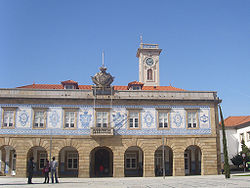 |
|
| Civil parishes of Póvoa de Varzim | |
|
|
Póvoa de Varzim is governed by a Câmara Municipal (City Council) composed of nine councilmen. A Municipal Assembly exists and it is the legislative body of the municipality, consisting of 39 members, twelve of whom are presidents of civil parishes.
After the 2009 municipal elections, five councilmen were members of the centre-right Partido Social Democrata
Social Democratic Party (Portugal)
The Social Democratic Party , is a centre-right liberal conservative political party in Portugal. It is commonly known by its initials, PSD; on ballot papers, its initials appear as PPD/PSD, with the first three letters coming from the party's original name, Democratic People's Party...
(PSD), three of the centre-left Partido Socialista
Socialist Party (Portugal)
The Socialist Party , abbreviated to PS, is a social-democratic political party in Portugal. It was founded on 19 April 1973 in the German city of Bad Münstereifel, by militants from Portuguese Socialist Action ....
(PS) and one of the right-wing Centro Democrático e Social - Partido Popular
Democratic and Social Center / People's Party
The Democratic and Social Centre – People's Party , abbreviated to CDS–PP, is a Portuguese political party, with an ideological foundation of Conservatism, Christian democracy and classical liberalism. In voting ballots its name appears only as People's Party, with the acronym CDS–PP unchanged.It...
(CDS-PP). The mayor is Macedo Vieira
Macedo Vieira
José Macedo Vieira is the president of the city council of Póvoa de Varzim since 1993 by the PSD party.He is also president of LIPOR Residues management body of Greater Porto, Council of Administration of Varzim lazer E.M, vice-president of Metro do Porto, SA and of Águas do Cávado,...
, for the PSD, elected with 46.29% of the votes. The PSD holds the majority of public offices both in the Municipal Assembly and in the civil parishes. After the first free elections, with the end of the Estado Novo period, only right-wing parties have governed the city: the city council was governed by the CDS
Democratic and Social Center / People's Party
The Democratic and Social Centre – People's Party , abbreviated to CDS–PP, is a Portuguese political party, with an ideological foundation of Conservatism, Christian democracy and classical liberalism. In voting ballots its name appears only as People's Party, with the acronym CDS–PP unchanged.It...
between 1976 and 1989 and since then by the PSD. The CDS saw its popularity suffer an abrupt decline in 1997, and has since then been the third political party. On the other hand, the PSD in the same year achieved its first absolute majority with 62.4% of the votes.
Póvoa de Varzim is the northernmost municipality in the Porto Metropolitan Area, about 27 km (16.8 mi) north of downtown Porto. Despite being enclosed in the northern metropolis, Póvoa de Varzim is part of the Association of Municipalities of the Ave Valley.
Between 1308 and 1836, the municipality was made up of a single parish territory of which, over time, grew to approach the medieval borders. With the administrative reform of the land in 1836, Póvoa de Varzim annexed Rates township, regained the remaining domains of Argivai, and obtained Balasar, Estela, Laúndos, Navais, Terroso, Outeiro Maior, Parada, Rio Mau, and Santagões. In 1853, it exchanged the preceding four with nearby Vila do Conde and got Amorim and Beiriz. The civil parishes of Aver-o-Mar and Aguçadoura were created in early 20th century through the dismemberment of Amorim and Navais, respectively. The settlement of Aver-o-Mar was first annexed in the 17th century due to an emergent community of fishing-farmers. On the other hand, Caxinas and Poça da Barca, south expansion areas of Póvoa de Varzim in the 18th and 19th centuries with fisher populations from Póvoa, are still administrated by Vila do Conde, in spite of the centuries-old requests of Póvoa de Varzim for these to be incorporated in its municipality.
The origin of the coat of arms of Póvoa de Varzim is unknown, but it certainly has local traits and symbolism. The coat of arms is composed of a golden sun and a silver moon; in the middle a golden cross completed by two anchor silver arms, representing safety at sea. Over the cross, a ring, of which falls a golden rosary that interlaces with the anchor arms, representing faith and divine protection. The crest is made of five silver towers due to its city status. The flag is broken in blue and white. Between 1939 and 1958, a different coat of Arms and flag were used, which the population criticized; it consisted of a golden shield, covered by a red net, the sea and a black Poveiro boat; the flag was plain red. The population did not accept these new symbols and years later the old ones would be restored.
Education

School
A school is an institution designed for the teaching of students under the direction of teachers. Most countries have systems of formal education, which is commonly compulsory. In these systems, students progress through a series of schools...
s in the city and rural areas. Public education in the municipality is provided by five school districts: Flávio Gonçalves, Cego do Maio, Aver-o-Mar, Campo Aberto, and Rates. These school districts arrange kindergartens and schools to the 9th grade of different locales of the municipality and are headed by Escolas de Educação Básica do 2.° e 3.°Ciclo (6th to the 9th grade schools) that give the name to each district. Private schools are primarily run by Catholic parishes or groups, but the Grande Colégio da Póvoa de Varzim and Campo Verde School of Agriculture are eminent independent schools and MAPADI is a large facility and school for children with down syndrome
Down syndrome
Down syndrome, or Down's syndrome, trisomy 21, is a chromosomal condition caused by the presence of all or part of an extra 21st chromosome. It is named after John Langdon Down, the British physician who described the syndrome in 1866. The condition was clinically described earlier in the 19th...
. Colégio do Sagrado Coração de Jesus, where Agustina Bessa-Luís studied, reopened in the 2007-2008 school year, planning to become a leading catholic school.

Póvoa de Varzim City Center
Póvoa de Varzim City Center or Downtown Póvoa de Varzim is the heart of Póvoa de Varzim in Portugal, and is the location for most of the city's municipal services, tourist attractions and businesses. It is the center, not only for the city or the municipality, but also neighboring municipalities...
: Escola Secundária Eça de Queirós and Escola Secundária Rocha Peixoto. The Colégio de Amorim is an independent school in the civil parish of Amorim that also offers secondary education. Eça de Queirós was a lyceum
Lyceum
The lyceum is a category of educational institution defined within the education system of many countries, mainly in Europe. The definition varies between countries; usually it is a type of secondary school.-History:...
created in 1904 that maintains its humanist outlook and Rocha Peixoto was a former industrial and commercial school created in 1924.
The Porto Polytechnic runs, jointly in Póvoa de Varzim and Vila do Conde, the Superior School of Industrial Studies and Management
Escola Superior de Estudos Industriais e Gestão
thumb|220px|right|Porto Polytechnic's Superior School of Industrial Studies and Management.The Escola Superior de Estudos Industriais e de Gestão or ESEIG is a higher learning polytechnic school in the conurbation of Póvoa de Varzim and Vila do Conde, Portugal.ESEIG was founded in 1990, as part of...
(ESEIG), which once was based in two campuses, one in each city, but it was united in a single new school, on the border between the two cities. A little more than one quarter of the population now has intermediate or superior level qualifications. The illiteracy level was 5.9 percent in 2001.
The Rocha Peixoto Municipal Library, established in 1880, on the 300th anniversary of the death of Luís de Camões
Luís de Camões
Luís Vaz de Camões is considered Portugal's and the Portuguese language's greatest poet. His mastery of verse has been compared to that of Shakespeare, Vondel, Homer, Virgil and Dante. He wrote a considerable amount of lyrical poetry and drama but is best remembered for his epic work Os Lusíadas...
was housed in the current building in 1991. Small libraries known as Pólos de leitura, located in the countryside, and Diana Bar Beach Library are extension posts of the municipal library.
Healthcare and security

Primary care
Primary care is the term for the health services by providers who act as the principal point of consultation for patients within a health care system...
building which has extensions in the main parishes.
The Municipal Police of Póvoa de Varzim, one of the first to be established in the country, is an administrative police force that acts solely within the municipality and reports directly to the mayor. The Polícia de Segurança Pública
Polícia de Segurança Pública
The Polícia de Segurança Pública - PSP is the Portuguese police force that works in large urban areas. Rural towns and areas are under the protection of the Portuguese Republican National Guard...
(PSP) does the city policing, while the Guarda Nacional Republicana (GNR) is responsible for the countryside. In terms of crime, Póvoa de Varzim is considered by the Polícia de Segurança Pública
Polícia de Segurança Pública
The Polícia de Segurança Pública - PSP is the Portuguese police force that works in large urban areas. Rural towns and areas are under the protection of the Portuguese Republican National Guard...
as a "calm" zone in all categories of offense; violent crime, in particular, is practically non-existent. Mostly, crime consists of minor robberies to homes, stores, or from cars.
Póvoa is one of the twelve national sea borders controlled by the Serviço de Estrangeiros e Fronteiras (SEF). The Escola Prática dos Serviços, just east of the city by the A28 motorway, is the national headquarters for military administration instruction, with the Battalion of Military Administration, and, due to the reorganization of army services, the former Escola Prática de Administração Militar, from 2006 onwards it gained the material and transport services, thus increasing its range of functions and troop numbers.
Transport

Light rail
Light rail or light rail transit is a form of urban rail public transportation that generally has a lower capacity and lower speed than heavy rail and metro systems, but higher capacity and higher speed than traditional street-running tram systems...
metro. These infrastructures and the airport, bus terminal, marina and harbour are daily used by commuters.
.jpg)

The Francisco Sá Carneiro Airport
Francisco Sá Carneiro Airport
Francisco Sá Carneiro Airport or simply Porto Airport is an international airport near Porto, Portugal. It is located approximately six miles northwest of Porto city centre, in the municipalities of Maia, Matosinhos and Vila do Conde and is run by ANA Aeroportos de Portugal...
(OPO) is located 18 km (11.2 mi) south of the city. It is one of the busiest international airports in Portugal and serves all Greater Porto. Póvoa Aerodrome, officially known as S. Miguel de Laundos, is small-sized, with only 270 meters long for ultralight aviation
Ultralight aviation
The term "ultralight aviation" refers to light-weight, 1- or 2-person airplanes., also called microlight aircraft in the UK, India and New Zealand...
and other small planes.
Line B of Porto Metro
Porto Metro
The Porto Metro , part of the public transport system of Porto, Portugal, is a light-rail network that runs underground in central Porto and above ground into the city's suburbs...
links Póvoa de Varzim to Porto and the airport with two services: a standard and a shuttle (the Expresso); through Verdes station, Metro trains link the city and the airport. The line operates on a former railway, which opened in 1875 and closed in 2002 to give way for the metro. The railway network was expanded and reached Famalicão in 1881, it was closed entirely in 1995 and expected to become a rail trail
Rail trail
A rail trail is the conversion of a disused railway easement into a multi-use path, typically for walking, cycling and sometimes horse riding. The characteristics of former tracks—flat, long, frequently running through historical areas—are appealing for various development. The term sometimes also...
.
The city is connected by road on a north-south axis from Valença
Valença, Portugal
Valença is a city in Valença Municipality, Portugal. It is a half-castle and half-land city. Bordering Galicia, Valença is also a famous Portuguese landmark to view an ancient castle town. These two parts of this city are not separated from each other and is also near to Viana Do Castelo....
, Viana do Castelo, and Esposende to Porto
Porto
Porto , also known as Oporto in English, is the second largest city in Portugal and one of the major urban areas in the Iberian Peninsula. Its administrative limits include a population of 237,559 inhabitants distributed within 15 civil parishes...
by the A28
A28 (Portugal)
A28 is a motorway in Portugal. It connects Porto to Viana do Castelo, further extending to Valença, on the border with Galicia . It crosses with the A27, A7, A11, and A41 motorways....
motorway. It is also reached by the A7
A7 (Portugal)
A7 is a motorway in Portugal. It connects Póvoa de Varzim to Vila Pouca de Aguiar, its main porpouse was to give a fast access to the shoreline by inland cities, such as Guimarães and Vila Nova de Famalicão, thus a toll is applied....
(from Guimarães
Guimarães
Guimarães Municipality is located in northwestern Portugal in the province of Minho and in the Braga District. It contains the city of Guimarães.The present Mayor is António Magalhães Silva, elected by the Socialist Party.-Parishes:-Economy:...
and Vila Nova de Famalicão
Vila Nova de Famalicão
Vila Nova de Famalicão is a municipality in the district of Braga, in the north of Portugal. It is composed of 49 parishes.The municipality has a population of 131,690 inhabitants and a total area of 201.7....
) and A11
A11 (Portugal)
A11 is a motorway in Portugal. It connects Apúlia to Amarante via Guimarães. A11 is operated by Aenor - Auto-Estradas do Norte, S.A....
(from Braga
Braga
Braga , a city in the Braga Municipality in northwestern Portugal, is the capital of the Braga District, the oldest archdiocese and the third major city of the country. Braga is the oldest Portuguese city and one of the oldest Christian cities in the World...
and Barcelos
Barcelos, Portugal
Barcelos is a city in Barcelos Municipality in Braga District. The city has a population of 20,625.-History:Originally a Roman settlement, it expanded and became the seat of the First Duke of Bragança in the 15th century...
) motorways on an east-west axis, through the south and north of the city, in that order, and both cross the A28. Although it lost usefulness for average and long distances, the National Roads system has acquired municipal interest: EN13 that cuts the city in half, in a north-south direction, is used by commuters originating from the northern parishes and from the city of Vila do Conde, in the south, to travel downtown. The EN205 and the EN206 are used by commuters starting from the interior of the municipality.
The traditional road system of the city, composed of roads that run parallel in the direction of the sea, can be seen in any of the following avenues: Avenida do Mar, Avenida Vasco da Gama, Avenida Mouzinho de Albuquerque, and Avenida Santos Graça. The Avenida dos Descobrimentos and Avenida dos Banhos
Avenida dos Banhos
Avenida dos Banhos, literally Baths Avenue, is the main waterfront street of the city of Póvoa de Varzim in Portugal. The long avenue runs from Passeio Alegre square, near the seaport of Póvoa de Varzim to Vasco da Gama Avenue.-History:...
, in other hand, run parallel to the coast. The growth of the city inland and northwards made ring road
Ring road
A ring road, orbital motorway, beltway, circumferential highway, or loop highway is a road that encircles a town or city...
s more important, this can be seen in Avenida 25 de Abril, an urban belt road.
Sister cities
Within the context of the European UnionEuropean Union
The European Union is an economic and political union of 27 independent member states which are located primarily in Europe. The EU traces its origins from the European Coal and Steel Community and the European Economic Community , formed by six countries in 1958...
, Póvoa de Varzim is twinned, since 1986, with the city of Montgeron
Montgeron
Montgeron is a commune in the southeastern suburbs of Paris, France. It is located from the center of Paris.Inhabitants of Montgeron are known as Montgeronnais.-Transport:Montgeron is served by Montgeron – Crosne station on Paris RER line D....
in France, with Rio de Janeiro
Rio de Janeiro
Rio de Janeiro , commonly referred to simply as Rio, is the capital city of the State of Rio de Janeiro, the second largest city of Brazil, and the third largest metropolitan area and agglomeration in South America, boasting approximately 6.3 million people within the city proper, making it the 6th...
(Brazil
Brazil
Brazil , officially the Federative Republic of Brazil , is the largest country in South America. It is the world's fifth largest country, both by geographical area and by population with over 192 million people...
) in 1989, with Eschborn
Eschborn
Eschborn is a town near Frankfurt am Main in the Main-Taunus district, Hesse, Germany. As of 2009, it had a population of 20,789, but boasts fulltime employment of over 30,000 people...
in Germany (since 1998) and Żabbar
Zabbar
Ħaż-Żabbar is the fourth largest town in Malta, with a population of 17,030 . Originally a part of Żejtun, Ħaż-Żabbar was granted the title of Città Hompesch by the last of the Grandmasters of the Knights of St...
in Malta
Malta
Malta , officially known as the Republic of Malta , is a Southern European country consisting of an archipelago situated in the centre of the Mediterranean, south of Sicily, east of Tunisia and north of Libya, with Gibraltar to the west and Alexandria to the east.Malta covers just over in...
(since 2001) and it received, due to the partnership with other European cities, the 1995 and 2005 Golden Stars of Town-twinning from the European Commission
European Commission
The European Commission is the executive body of the European Union. The body is responsible for proposing legislation, implementing decisions, upholding the Union's treaties and the general day-to-day running of the Union....
.
| Montgeron Montgeron Montgeron is a commune in the southeastern suburbs of Paris, France. It is located from the center of Paris.Inhabitants of Montgeron are known as Montgeronnais.-Transport:Montgeron is served by Montgeron – Crosne station on Paris RER line D.... (France France The French Republic , The French Republic , The French Republic , (commonly known as France , is a unitary semi-presidential republic in Western Europe with several overseas territories and islands located on other continents and in the Indian, Pacific, and Atlantic oceans. Metropolitan France... ) 1986 Rio de Janeiro Rio de Janeiro Rio de Janeiro , commonly referred to simply as Rio, is the capital city of the State of Rio de Janeiro, the second largest city of Brazil, and the third largest metropolitan area and agglomeration in South America, boasting approximately 6.3 million people within the city proper, making it the 6th... (Brazil Brazil Brazil , officially the Federative Republic of Brazil , is the largest country in South America. It is the world's fifth largest country, both by geographical area and by population with over 192 million people... ) 1989 |
Eschborn Eschborn Eschborn is a town near Frankfurt am Main in the Main-Taunus district, Hesse, Germany. As of 2009, it had a population of 20,789, but boasts fulltime employment of over 30,000 people... (Germany Germany Germany , officially the Federal Republic of Germany , is a federal parliamentary republic in Europe. The country consists of 16 states while the capital and largest city is Berlin. Germany covers an area of 357,021 km2 and has a largely temperate seasonal climate... ) 2010 (partner city between 1998–2010) Żabbar Zabbar Ħaż-Żabbar is the fourth largest town in Malta, with a population of 17,030 . Originally a part of Żejtun, Ħaż-Żabbar was granted the title of Città Hompesch by the last of the Grandmasters of the Knights of St... (Malta Malta Malta , officially known as the Republic of Malta , is a Southern European country consisting of an archipelago situated in the centre of the Mediterranean, south of Sicily, east of Tunisia and north of Libya, with Gibraltar to the west and Alexandria to the east.Malta covers just over in... ) 2001 (partner city) |
See also
- List of notable residents of Póvoa de Varzim
- Sculptures in Póvoa de Varzim
- Landmarks in Póvoa de Varzim
- Aguçadora Wave Park
External links
- Portal Municipal - official website of the city
- Biblioteca Municipal Rocha Peixoto - City libraries
- Póvoa Semanário - News weekly
- A Voz da Póvoa - News weekly
- Tourist Map

